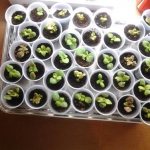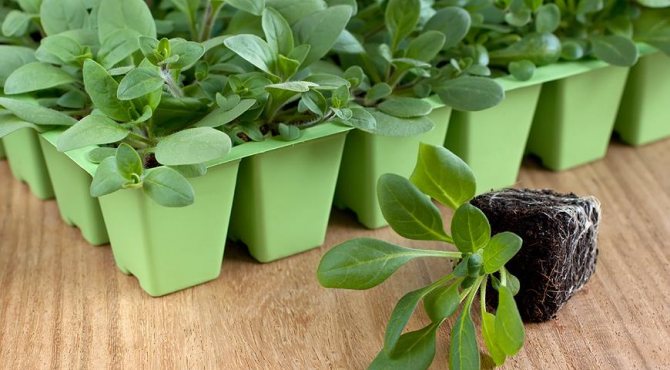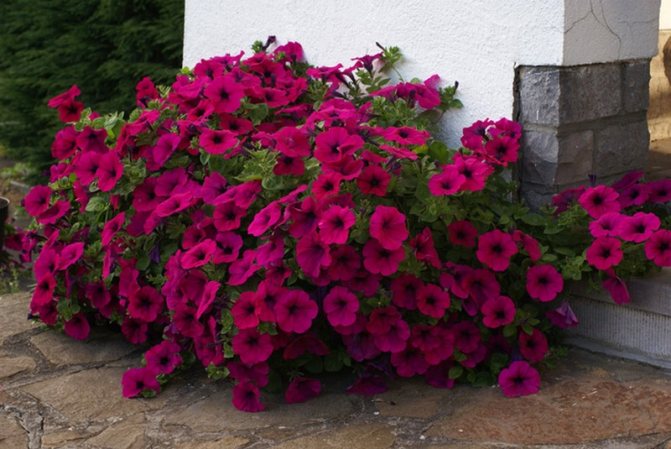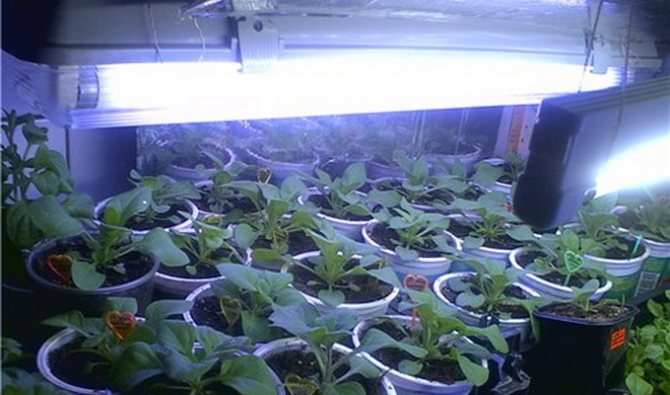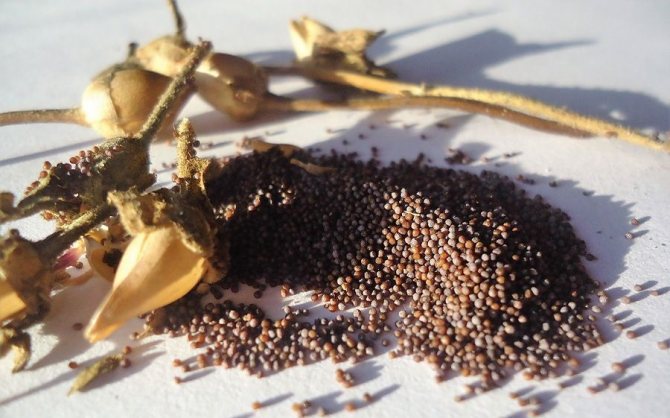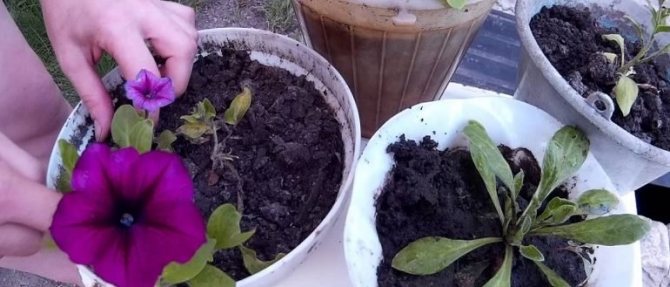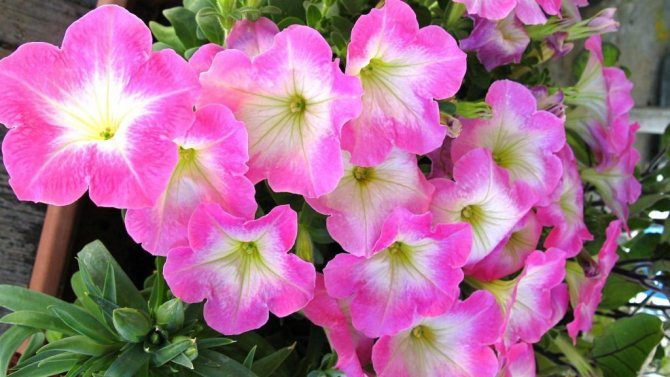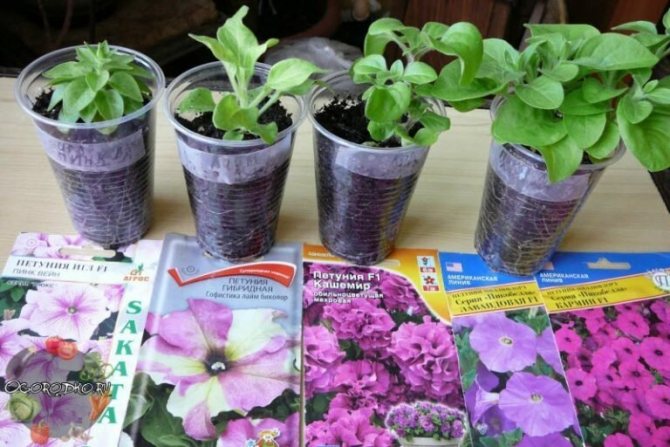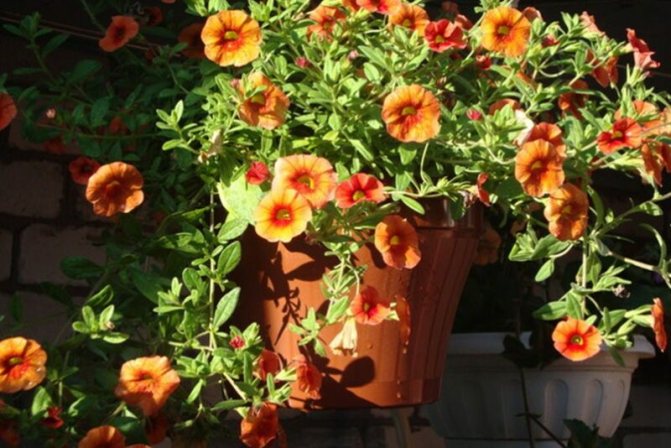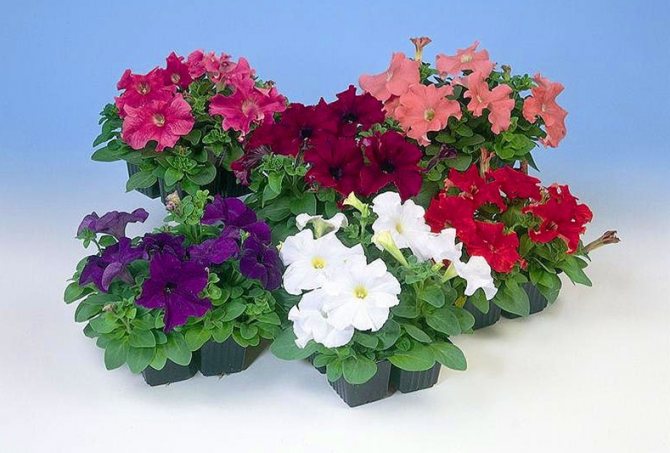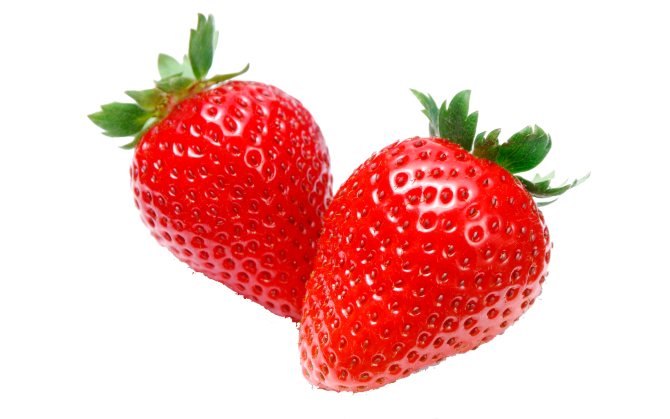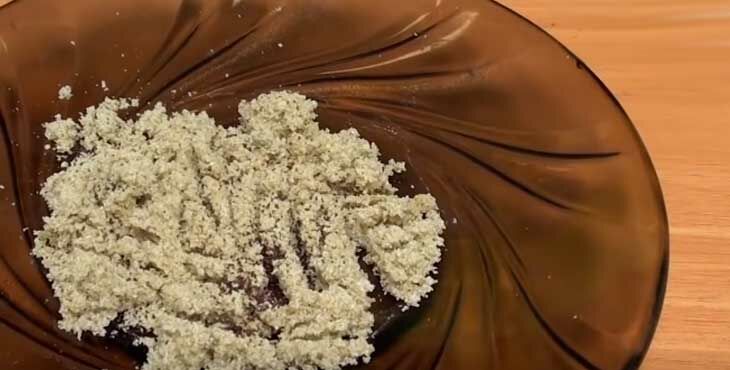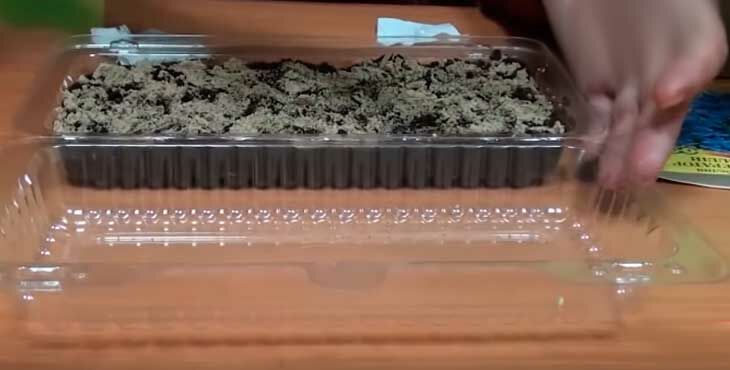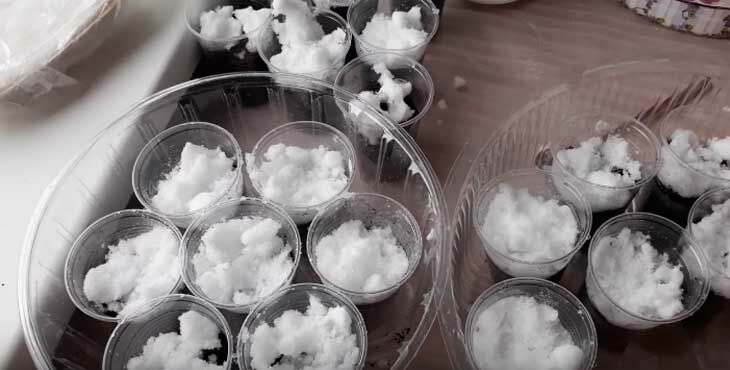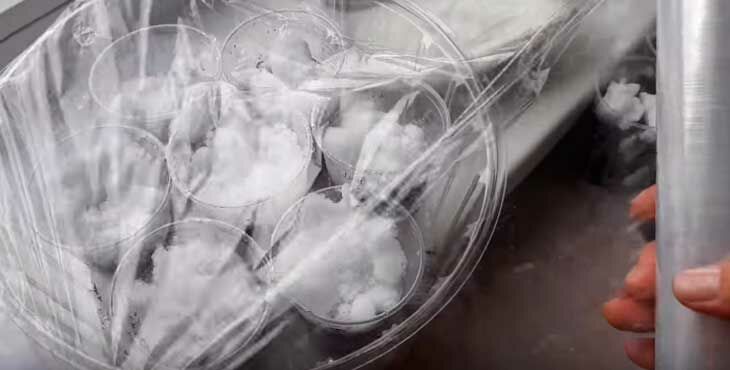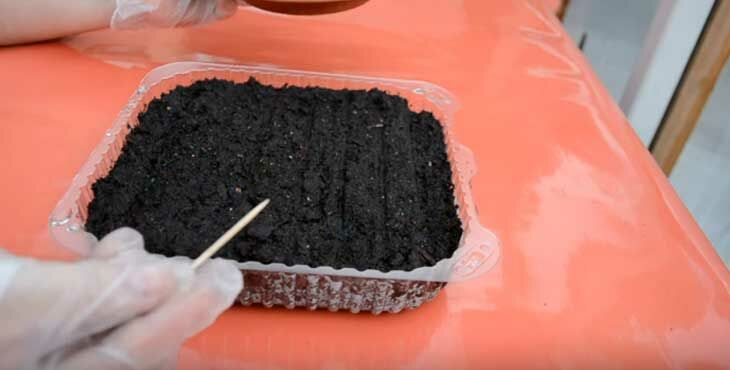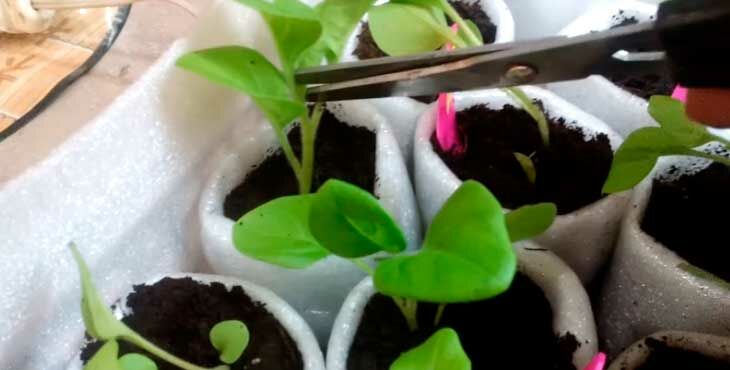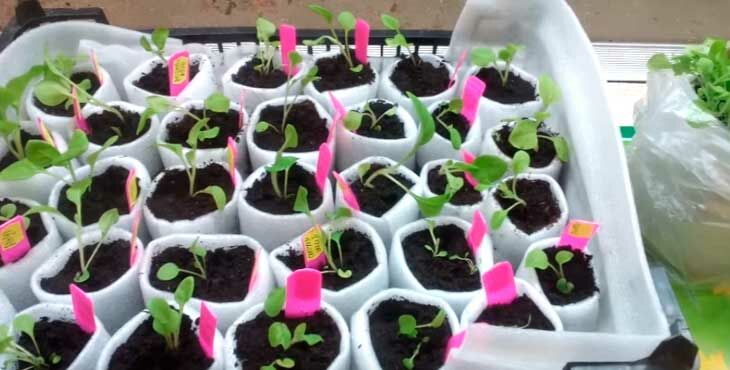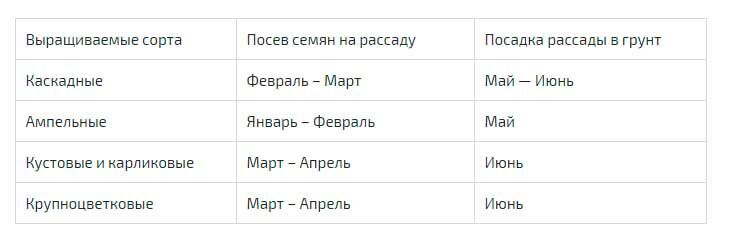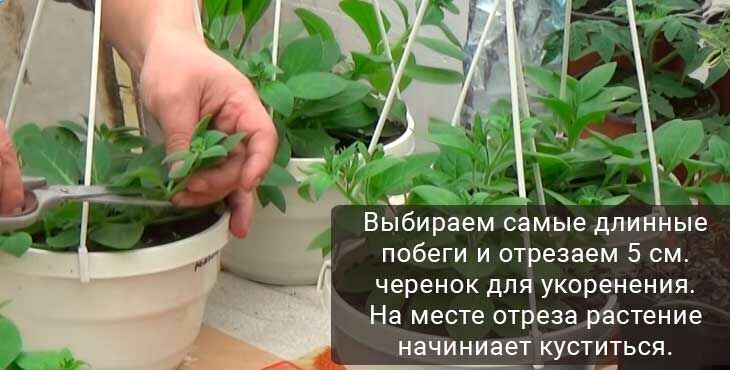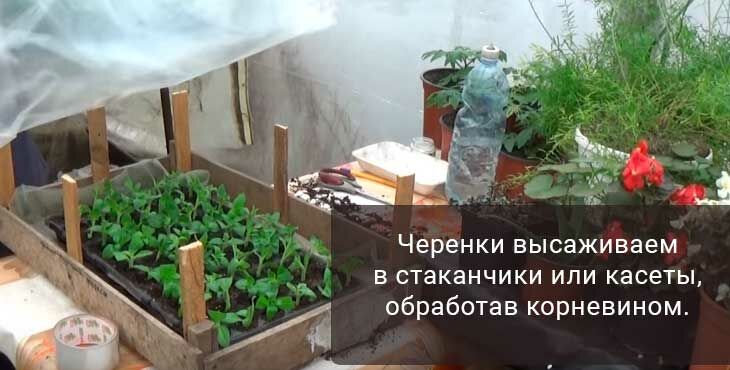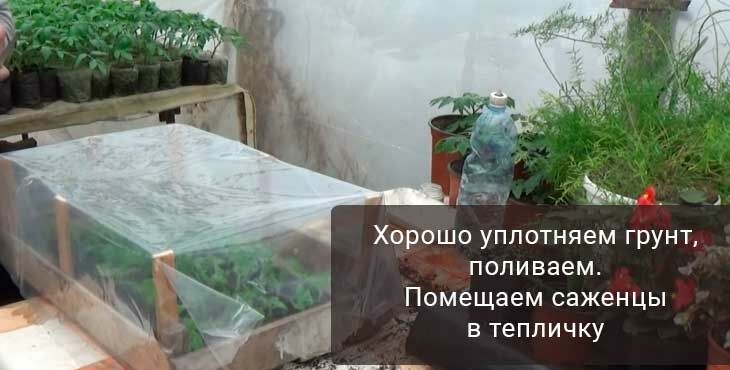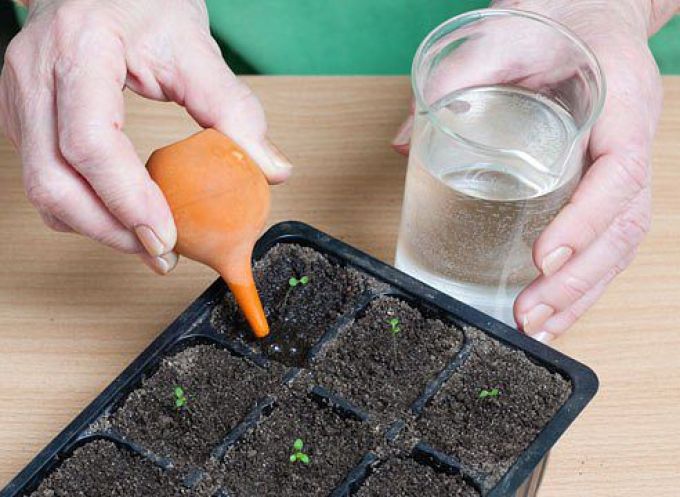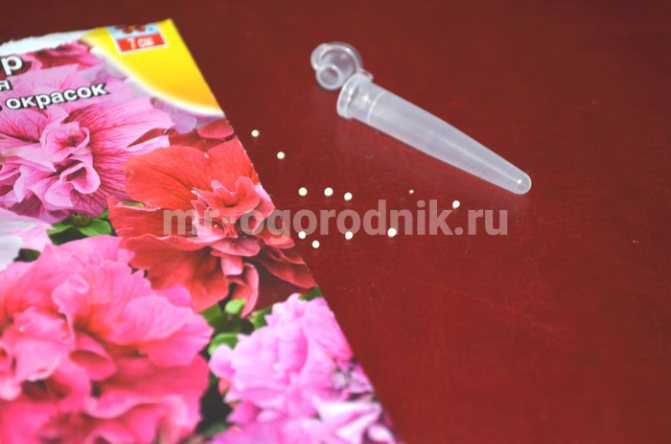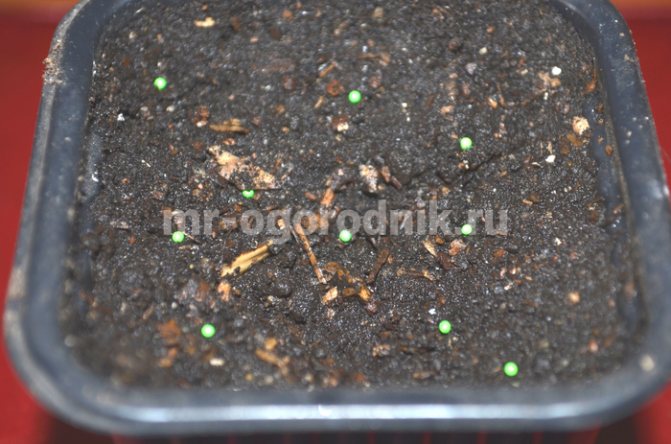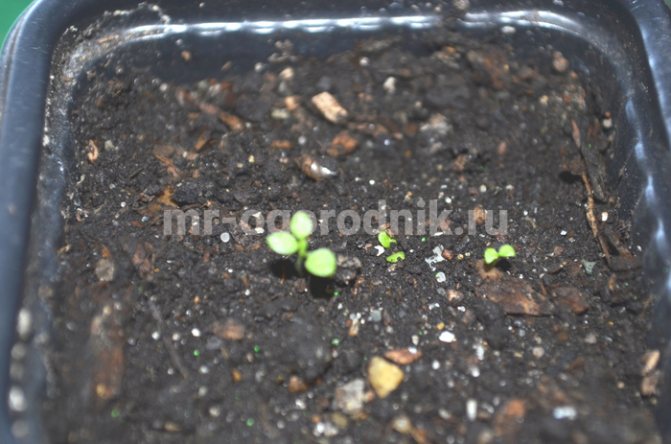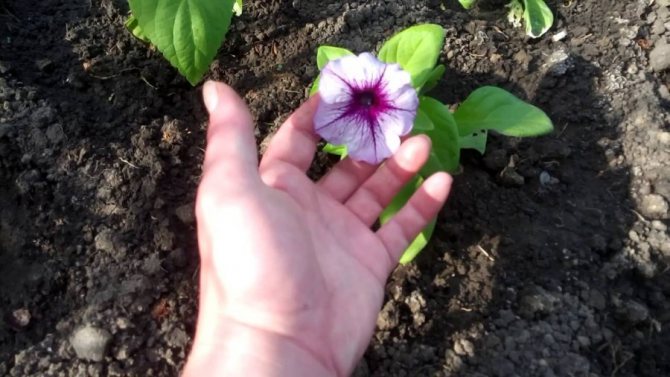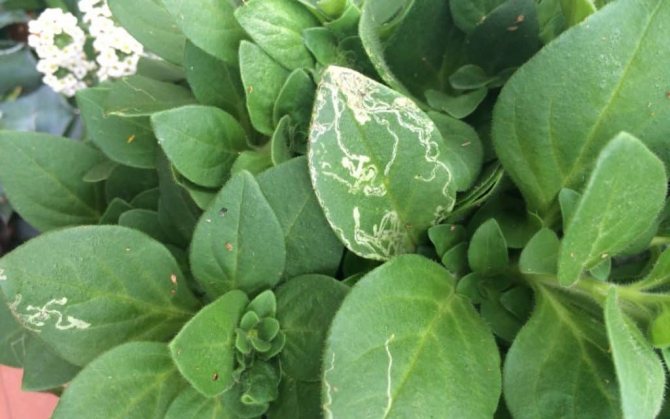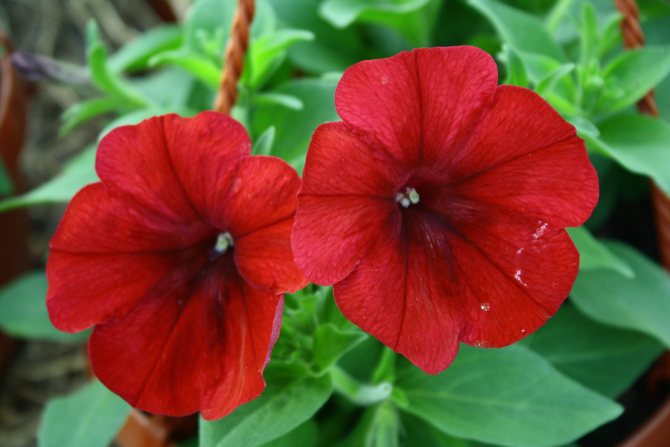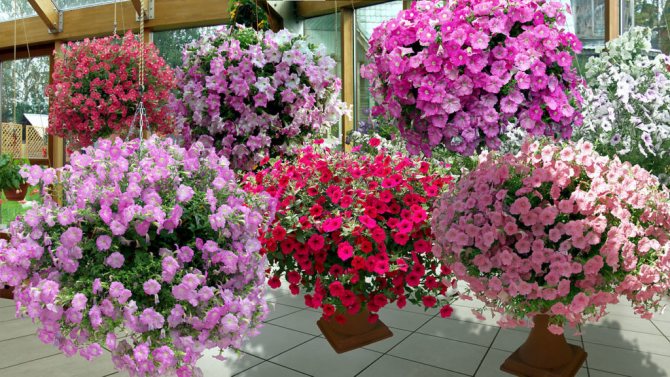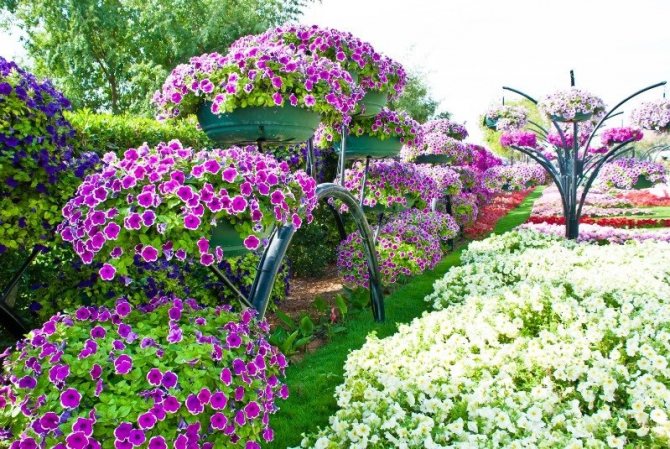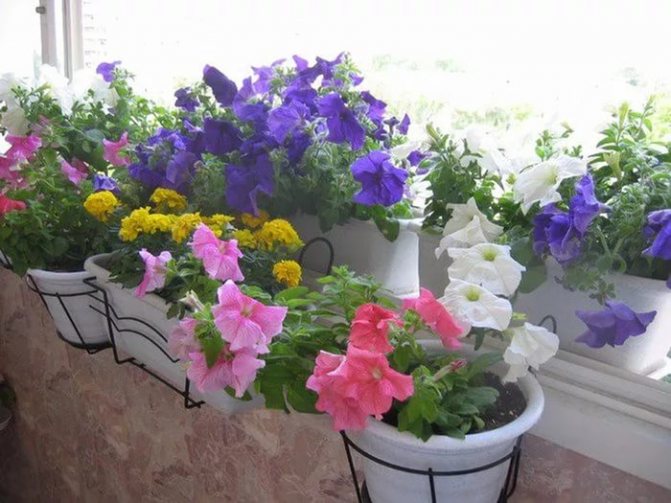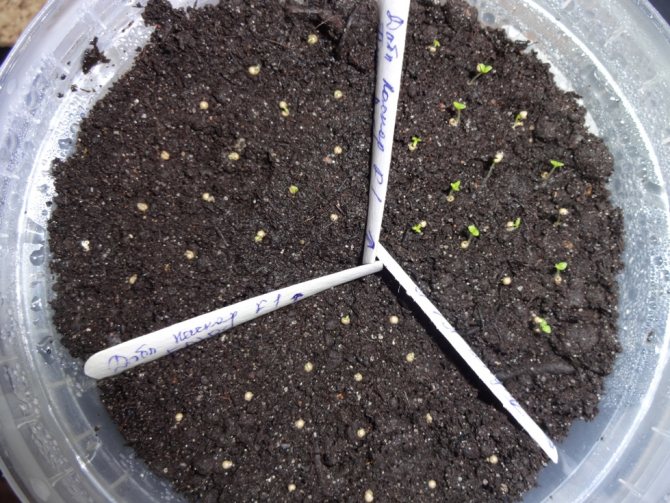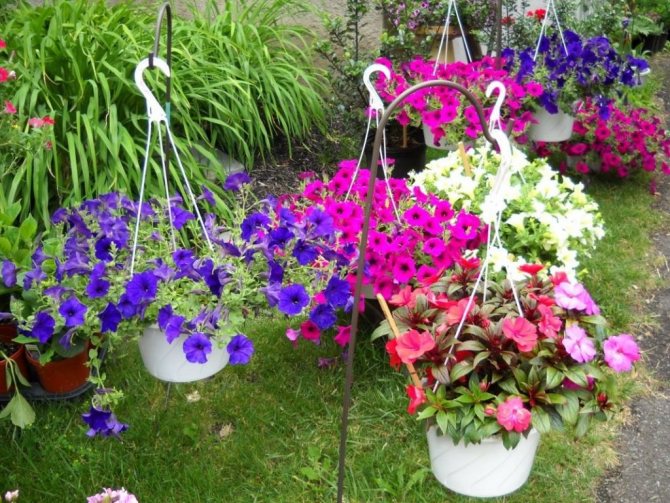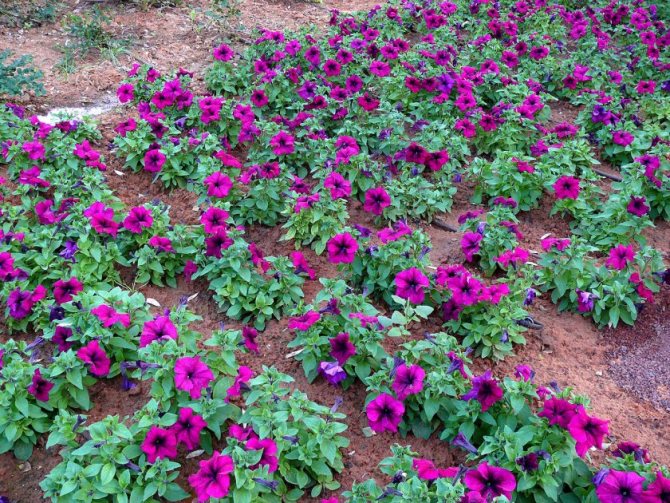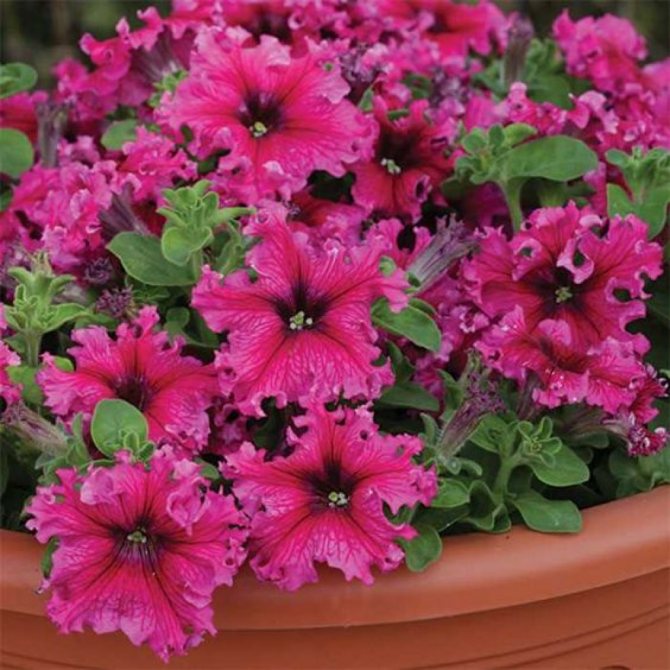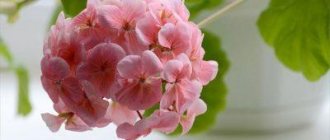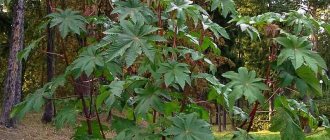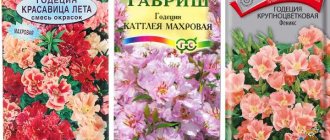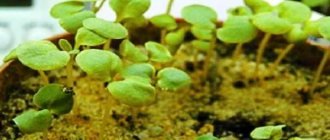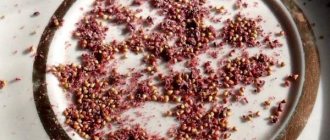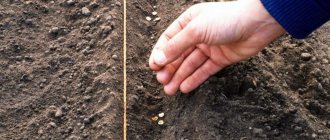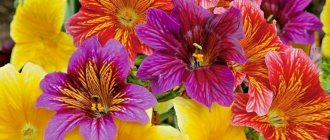Petunia is a decoration of any garden, summer cottage, private house and balcony. The spectacular flower pleases for a long time with bright "gramophones" of various shades, tolerates low temperatures well, and is unpretentious in care.
When to plant petunias for seedlings? How do I prepare the seeds? How to properly care for young sprouts? What diseases and pests are dangerous? Why is petunia necessary to grow seedlings? How to protect sprouts from aphids, slugs, spider mites, thrips? Answers in the article.
When to plant seeds for seedlings?
In order for the petunia to sprout well, certain favorable conditions are required. Experienced flower growers know them, but a novice flower lover can make mistakes in choosing the time to start planting. So when to plant petunias for seedlings? For a favorable seed germination and flower growth, a sufficient amount of natural light is needed, that is, the day must be long. Therefore, planting should not be done earlier than March. It is even better to highlight the seedlings additionally with a special lamp.
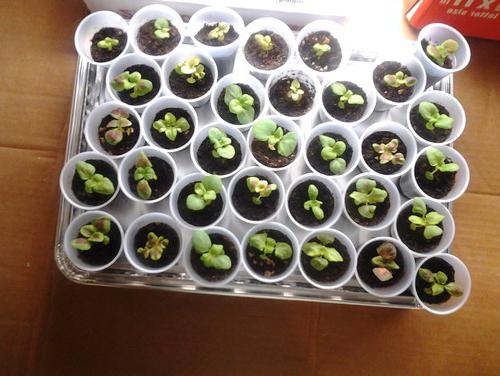
When to plant petunias for seedlings if the gardener wants to use different varieties of flowers? Simultaneously or not? Plant ampel varieties first, as they need more time to grow (some gardeners advise to plant them in January). Be aware that small-flowered varieties bloom first, so plant them last.
Diseases and pests of petunia seedlings, how to deal
Parasitic insects often attack young flowers. The stronger the seedlings, the lower the risk of severe damage to the seedlings. It is important to adhere to the rules for processing soil and seeds, monitor the quality of the soil, do not flood the soil - and an insect attack will become less likely.
The table shows the main parasites that annoy petunia, as well as methods for their destruction:
| Pests | Control measures |
| Thrips | Parasites inhabit all parts of the plant. First, the leaves are washed, peduncles and buds are removed, a layer of substrate 2-3 cm thick is removed. The best option is to spray insecticides + watering the soil to destroy individuals at different stages of development. Effective drugs: Fitoverm, Iskra, Aktara, Aktellik, Agrovertin. After applying the composition, cover the seedlings with a plastic bag: this way the insects will sooner die. Be sure to process petunia after 7-10 days, if necessary - a third time. The drug Spintor of a new generation is a product based on natural ingredients, the treatment is carried out according to the instructions |
| Spider mites | First, white sticky threads are collected, parasites are removed from the surface of the soil and the aerial part of the seedlings. It is important to cut off the top of the soil to remove the young mites so that the larvae do not eat the roots. Spraying seedlings with warm water, application of insecticides Fitoverm, Actellik, Sunmayt, Kleschevit, Oberon, Floromite |
| Slugs | Collect pests by hand, remove the top layer of soil, remove the affected leaves. It is important to exclude access to seedlings: paths of dry nettle leaves or spruce (pine) needles are poured around the pots or boxes. Spraying the soil with 1.5% ammonium nitrate solution, Thunder and Meta preparations, and instant coffee extract helps |
| Aphid | The seedlings are treated as early as possible, until tiny, light green insects have damaged all parts of the plants. The most effective method is the use of insecticides. At home, experienced florists advise using a large plastic bag, in which they make a small hole, spray the product. Pests will die if the air is closed: tie a bag around boxes with seedlings or an individual pot, be sure to seal the hole after processing. A good result is given by the following formulations: Fitoverm, Karbofos and other means of the pyrethroid group, neonicotinoids, with organophosphate components |
Petunia suffers not only from the attack of harmful insects, but also encounters fungal, viral, bacterial infections. Some problems cannot be solved: the seedlings die, but in many cases there is a chance for the survival of the seedlings.
You can find out about the diseases and methods of treatment of young petunias from the following table:
| Types of diseases | Causes of defeat, how to treat a plant |
| Bacterial and viral infections. Leaf galls, cucumber and tobacco mosaic virus, tomato aspermia, potato Y-virus | Infection occurs from neighboring crops when growing petunias. Viral diseases are detected less frequently than fungal infections and bacterial infections. What to do? Prepare seeds for planting, use high-quality soil, follow the rules for growing seedlings so that the sprouts are strong and healthy. Closely monitor the condition of plants in neighboring beds and flower beds: in most cases, viruses "pass" to petunias from tomatoes, potatoes, and other crops at their summer cottage. |
| Fungal infections | Gray rot, black leg. Reasons: heavy, too acidic and waterlogged soil, thickened plantings, untimely removal of diseased plants, excess nitrogen fertilizers. Avoid thickened plantings, water moderately, prevent root rot, water the ground with a fungicide solution (Fundazol), do not plant petunias in regions where dew often falls and the air humidity is high. Spray for prophylaxis with copper-containing preparations, moderately apply nitrogen fertilizers. Low temperatures - harm to seedlings |
How to choose the right petunia seeds?
When we plant petunias for seedlings, we already understood, it's time to figure out the choice of good seeds. The landing result depends on this decision, because low-quality ones may simply not ascend. How do you know if the seeds you want to buy are really good quality?
- High-quality viable petunia seeds are packaged in 5-10 pieces in one bag. If you have a bag containing 100 or more granules in front of you, this is a bad, low-quality product. You shouldn't buy it.
- Pay attention to the price, no need to chase cheap goods and discounts. Buy seeds at a price of 20 rubles per bag, cheaper options are most likely fake.
- It is very good if the seeds are packed in a protective flask, such a product is of high quality and almost one hundred percent germination.
- You should not buy seeds in supermarkets, it is better to visit a specialized store. Planting petunias for seedlings is a responsible occupation, and the seeds must be of the best variety. You should take care of every nuance to get a really good result.
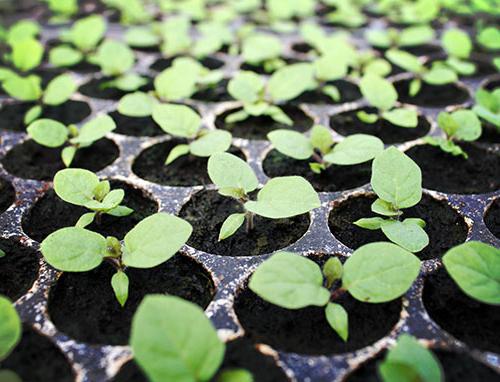

Selection of varieties and quality seed
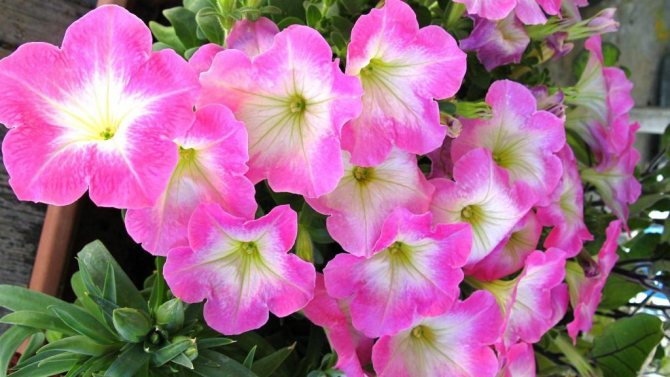

Multi-flowered petunias
A distinctive feature of petunia, which contributed to its popularity, is a huge variety of species and varieties. There are several main varieties of this flower:
- Bush petunias with large flowers (up to 10 cm in diameter)
- multi-flowered (flowers up to 3-5 cm);
- ampelous (creeping);
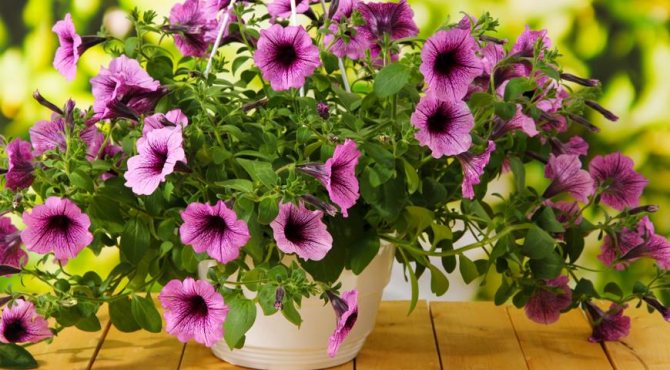

Ampel petunias
- undersized (height can reach only 15-30 cm).
Which variety to choose depends largely on where the petunia will grow.For indoor cultivation, dwarf varieties are suitable, which fit perfectly on the windowsill, or ampelous, if there is somewhere to hang them.
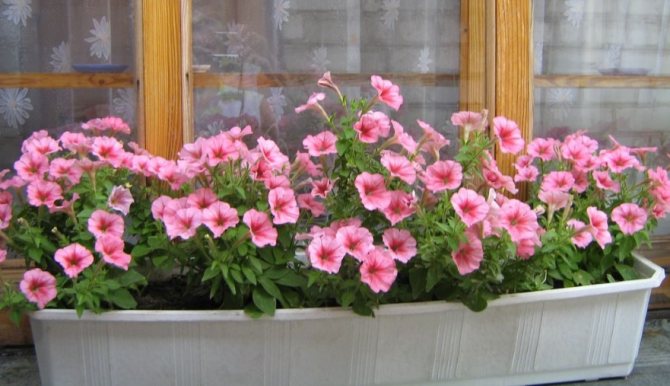

Window sill decoration
The latter include the varieties Conchita, Futura, Cascadia, Surfinia, Supertunia. Among the dwarfs, P. Merlin, P. Erfurt Dwarf, and others are very popular.
For flower beds and borders, bush and multi-flowered species will be appropriate. However, in this case, it must be borne in mind that most multi-flowered petunias are very sensitive to the weather, their decorative effect can be severely affected by wind or rain.
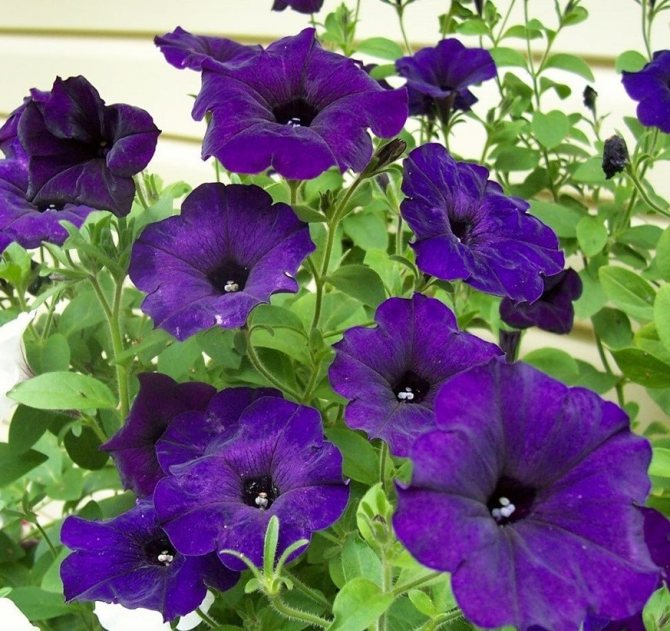

Bush petunia
Popular varieties of bush petunias:
- Daddy;
- Pikoti;
- Anastasia;
- Fantasy;
- Frillitunium;
- Double Cascade;
- Sonata;
- Pirouette.
The following varieties are referred to as multi-flowered:
- Fentasy;
- Prime Time;
- Plum Crystals;
- Charm;
- Mirage.
Strong and abundant seedlings depend not only on the correct variety, but also on the quality of the acquired seeds. Indeed, only in this case it will be possible to get the plants shown on the package.
When choosing a seed, you need to pay attention to several nuances:
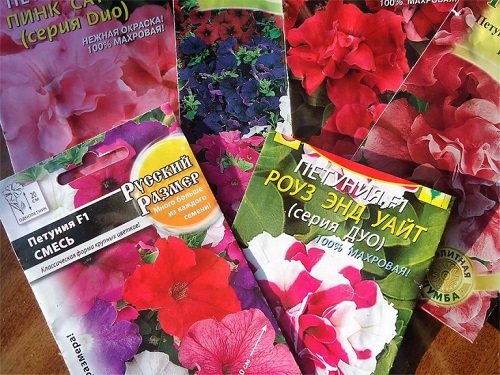

Petunia seeds
1. Quality tested seeds are never sold in 100-200 pieces per bag. As a rule, their number does not exceed 5-10 seeds.
2. Also, the price can serve as a kind of indicator. Seeds that are too cheap are likely to be of poor quality and will not sprout. On average, the price of petunia seeds starts at 20 rubles per package. If the variety is rare, the price may be higher.
3. The packaging also demonstrates the quality of the seeds. Tight, undamaged, with a protective layer or even with a protective flask - such packaging will be a sign of high quality seed.
4. The best place to buy seeds is in specialty stores (including online stores). You should not buy seeds for planting in stalls, because in this case, no one can guarantee their qualities.
Petunia seeds can be of two types: pure or with a shell. Each option has its own advantages, for example, clean seeds are cheaper, but if all planting rules are followed, they will give good shoots. On the other hand, the shell protects the seeds from various diseases, damage and greatly facilitates the process of sowing them in the ground.
In which container is it better to place the seedlings?
Seedlings of petunias, the cultivation of which is not easy, requires a certain capacity. Most often, these flowers are grown in plastic containers. The height of the dishes you have chosen should not be lower than 10 cm. You can plant petunia in disposable plastic cups or use special cassettes with various heights and the number of cells. It is very convenient.
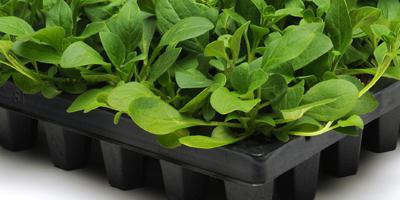

Experienced gardeners do not recommend planting flowers in cardboard containers (for example, from under milk). First, it can leak from watering. Secondly, such a container is an excellent environment for the development of various flower diseases. Thirdly, in order to accumulate a sufficient amount of this container, the hostess will have to store all these packages at home, which not every woman will like.
Why should petunia flowers be grown through seedlings?
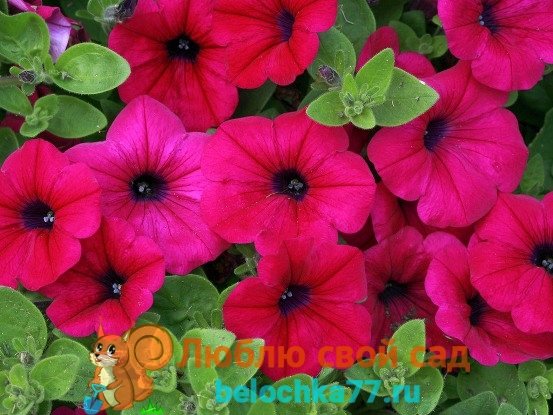

Petunia is a small-seeded, long-growing plant and is grown as seedlings. If you sow seeds directly into the ground, then flowering will come only at the end of summer. With early frosts, flowers may not be seen.
Petunia from seeds can be grown in any quantity and, if desired, decorate not only a flower bed, but also refine paths, gazebos, terraces, a balcony, a platform near the fence, flowerpots and hanging pots.
Seedlings obtained with one's own hand gives a guarantee of the safety of seedlings, and this is the main requirement when choosing flowers.After all, sick and infected plants can not only die themselves, but also destroy nearby flowers.
How to prepare the soil for planting?
We have already covered the questions of when to plant petunias for seedlings and how to choose seeds and containers. Let's move on to an equally important issue - soil preparation. The quality of flower shoots depends on its quality and composition. For favorable conditions for the growth of seeds, the soil needs a moisture-consuming and rather loose soil. It is best if you mix your own soil for planting seeds. To do this, take sod, peat and humus or peat, sand and soil from the garden. Mix the constituent parts in equal proportions. If you purchased the soil in the store, then be sure to improve it. Add to 5 kg of store soil half a liter of ash, 250 grams of perlite and a spoonful of any fertilizer saturated with potassium. Seedlings of petunia at home in such a soil always grows successfully and quickly. Be sure to lay out the bottom of the container with expanded clay for drainage.
How to properly grow petunia from seeds
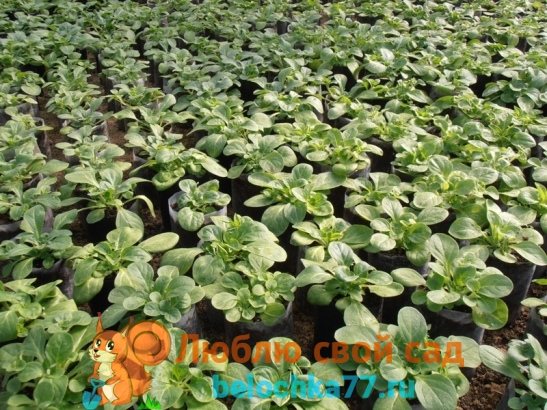

The seeds collected from the plants are very small and many gardeners have a problem with sowing in the form of thinning.
To simplify this procedure, growers buy ready-made granules that dissolve in moist soil and accelerate plant growth. The next year, having gained experience, you can safely sow self-collected seeds.
Attention! Seeds harvested from hybrid plants will not retain their parental properties! But it is all the more interesting to see what will grow!
Sowing
The soil for sowing should have a neutral or slightly acidic environment. We prepare the earth in advance so that it is loose, nutritious, and moisture-permeable.
The soil mixture can be bought at a specialty store or prepared at home. The mixture will require:
- 2 parts of turf,
- peat,
- rotted humus,
- coconut substrate
- 1 part sand.
To normalize the acidity of the soil, charcoal and lime are added to the mixture. All components are mixed and sieved on a coarse and fine sieve.
The finished mixture is calcined in the oven or spilled with boiling water.
The sowing container (boxes, pots, containers) must be deep enough, at least 10 centimeters, and have holes for water drainage. For drainage, small expanded clay or perlite is poured into the bottom of the tank. Then there is a large screening, from above the remaining third of the container is filled with small screenings.
The soil is pressed a little and watered with warm water. Seeds are laid out in rows, with a toothpick and sprayed with water. The seeds can be mixed with sand and sown without using any tools at hand.
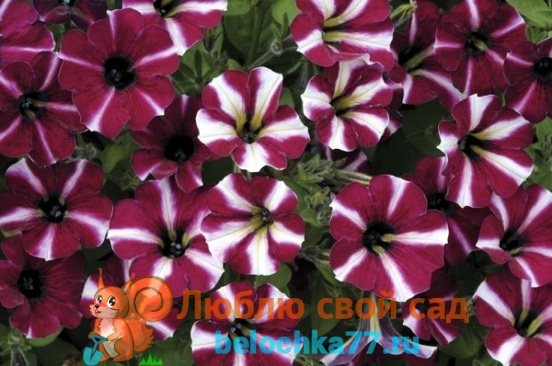

When sowing without using sand, you can use a sheet, which, when bent, will allow the seeds to roll down one by one and not thicken the planting. For a tighter contact with the ground, the seeds are pressed slightly.
Attention! Do not sprinkle with soil!
For easier cultivation, peat tablets are used.
- They need to be soaked in boiling water and cooled.
- Then, with tweezers, a toothpick, insert the seeds into special grooves.
- The tablets are placed in a container.
After that, regardless of the sowing method, the container is covered with a transparent film, glass. The temperature under the shelter should be 24 degrees.
At lower temperatures, germination, especially in hybrids, will be poor or not at all. The high temperature leads to the stretching of the sprouts and their diseases.
To obtain a sufficient amount of moisture, seedlings are sprayed with water with the addition of potassium permanganate 3-4 times a day. Such conditions allow the seeds to germinate for 7 days.
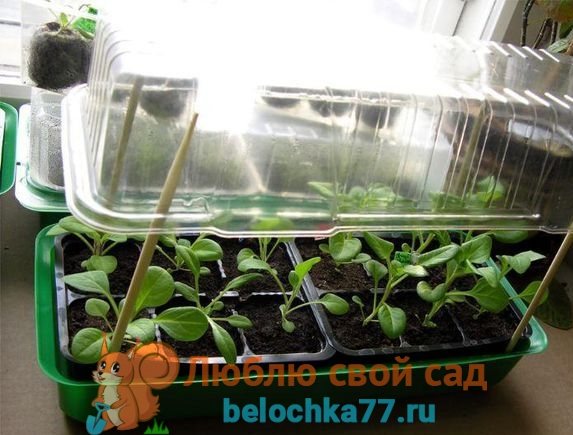

Convenient to grow petunias in a container with a lid, can be ventilated
After the emergence of seedlings, the cover is removed from the film. If glass was used, then gradual hardening is carried out, in the way of removing the protection for 5 minutes, then for 10, 20, and so on, until the sprouts get used to room temperature. This usually happens when the first leaves appear.After the first shoots, the seedlings are exposed in a bright place.
Plants should not be exposed to direct sunlight.
Picking
When 2-3 true leaves appear (1 - 1.5 months after sowing), the seedlings are picked. The soil mixture is taken the same as for sowing. Before planting, it is watered with a weak solution of potassium permanganate.
Plants in individual containers quickly adapt to new conditions, grow and get stronger. The planted seedling is buried in the ground up to the first main leaves. This will allow the plant to develop a strong and healthy root system and not develop blacklegs.
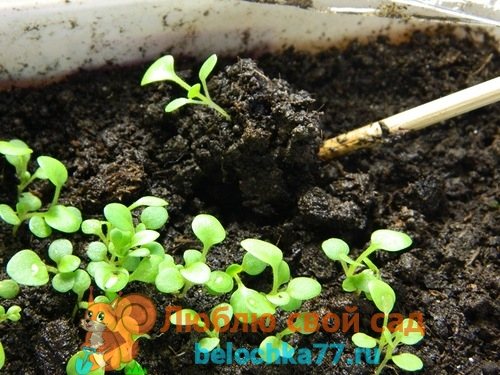

A toothpick or a match can help transplant babies
Small petunias appear very weak in appearance, with a root thinner than a hair, but this is deceiving. They are very tenacious, grow well after transplantation, do not be afraid if the root tip comes off during transplantation - this is even good.
If you sowed petunias often and they sprang up together in a whole bunch, then transplant in small bouquets of 5-6 plants, let them grow. After transplanting into the ground and pinching correctly, you will get a gorgeous flowering bush!
Seedlings in peat tablets are simply transplanted into plastic cups, peat pots or cassettes.
Do not worry that the seedlings grow very slowly at first - in the first half of the cultivation this is the norm, then the green mass will grow very quickly.
Seedling care
To obtain a healthy and strong petunia seedlings, you need to make timely and accurate watering. Drying out of the soil leads to the death of plants, and waterlogging leads to disease and death of seedlings. Watering the grown plants in separate containers is done carefully under the root. Only with warm water.
Do not water over the leaves - they can get sick!
For hardening from the second week, the window is slightly opened for 10 minutes, so the temperature in the room will drop. In this case, a direct flow of cold air and a draft must be excluded. The seedlings themselves should not cool down.
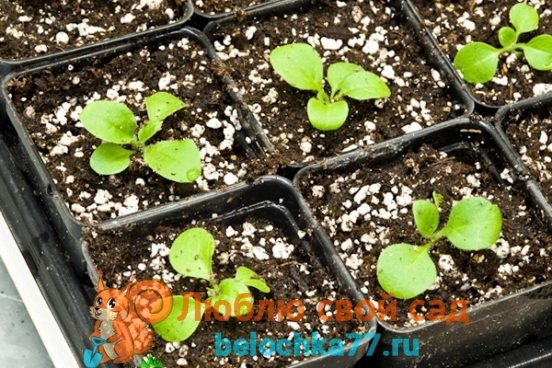

Fertilizers are applied half a month after picking seedlings. First, the leaves are sprayed with liquid fertilizer every 2 days. Complex mineral fertilizers with an admixture of nitrogen should alternate with growth stimulants. Then, for the entire period of growing plants before transplanting to a permanent place of growth, feeding is done 2 more times.
When the root system fills the entire space of the pot, the plants are transplanted into larger containers. If the plants grow in peat pots, planting is done with the pot.
If the petunia begins to stretch, you need to add potting soil.
For the first month and a half, the root system develops in petunia, and the aerial part develops slowly, in the future everything happens the other way around and the plant grows.
Watering
Watering the grown plants in separate containers is done carefully under the root. Watering frequency depends on the soil. The earth should not dry out.
The formation of a crust after watering is excluded, since the seedlings suffocate and die. Condensation formed on the film (glass) is removed daily.
Lighting up
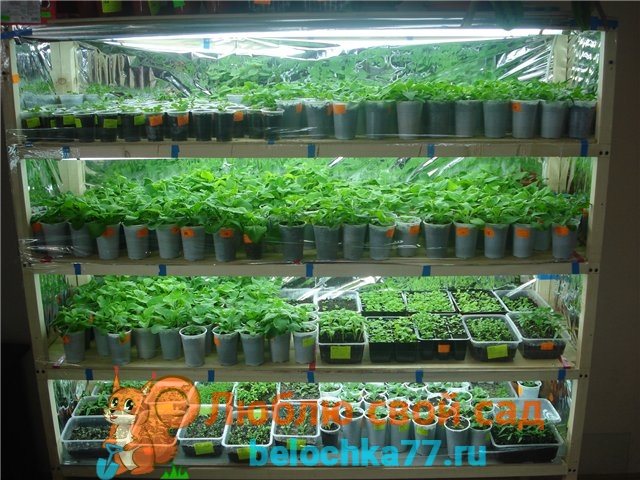

Light for seedlings of petunias is needed almost around the clock. In gloomy weather, the light turns on during the day, and at night, a dim light turns on. The lamp must be located at a great distance, otherwise the plants may get burned. Daylight hours for petunias should be at least 16 hours a day.
Pests and diseases
Viral diseases manifest themselves in the form of yellowing of leaf veins, discoloration of foliage, and growth retardation. The carrier of the disease is most often aphids. Control measures are to remove diseased seedlings.
Petunia is susceptible to such diseases as: black leg, root rot, gray rot, chlorosis, powdery mildew, downy mildew, fusarium.
To combat diseases, appropriate drugs are used: Ferrovit, Albit, Emerald, Planriz Topaz, Skor, Previkur, Fundazol, systemic fungicides.
In addition to diseases, many pests affect petunia.
When thrips appear, young leaves are deformed, the growth point is bent. Flowers become stained and turn brown. To combat the pest, sticky traps are placed in the flowers.
For complete disposal, Aktara, Confidor, Biotlin are used. Spraying is carried out 2 times with an interval of 4 days.
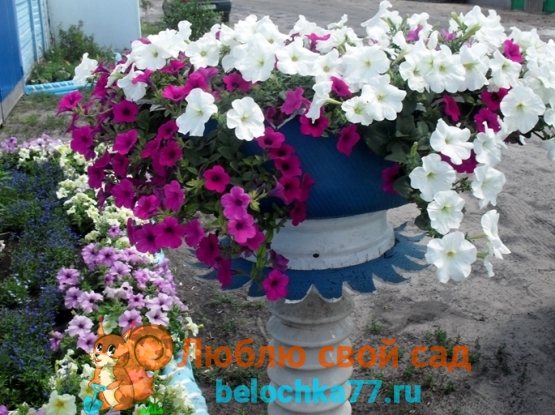

For successful flowering, it is necessary to prevent the appearance of diseases and pests.
Aphids lead to curly leaves, buds, flowers, and their further yellowing. A sticky discharge appears on the plants. Single lesions are sprayed with soapy water, with a larger lesion, Actellik, Antitlin, Aktara are used.
Caterpillars are collected by hand or plants are sprayed with chemical, biological insecticides.
To combat snails and slugs, mechanical traps, metaldehyde, dolomite flour are used.
When miners appear on the plants, the plants are immediately removed. To combat the pest, Karbofos, Actellik, Fufanon are used.
Sowing seeds in granules
If you want to grow expensive or rare varieties, it is better to use peat tablets. The pelleted seeds are moved into the ground with tweezers. Planting scheme for petunias 3 by 3 centimeters. With cassette planting, one seed is planted. Such a planting allows you to preserve the plants without subjecting them to picking and keep their root system intact.
Sowing in the snow
When sowing your own seeds, there are many ways to carry out this procedure. The seeds can be sown in the snow. Snow is spread in a thin layer on the surface of the soil, the seeds are sown and, if necessary, spread over the surface with a toothpick.
When to plant outdoors?
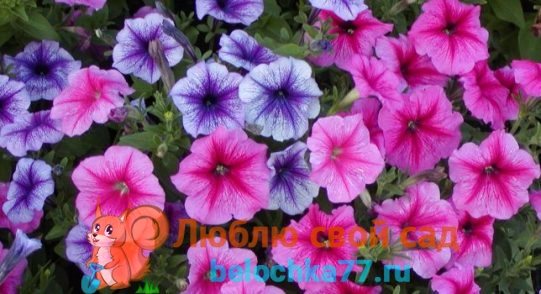

Planting petunias must be done in a sunny place on the south side of the site. Most often this happens in mid-May - early June, so that the repeated frosts have already passed.
The soil should be fertile, moist, loose and well warmed up. Fertilizers are introduced in the form of humus, double superphosphate, potassium sulfate and, if necessary, ash. A distance of half a meter is maintained between the plants. Disembarkation takes place in the early morning or evening.
After planting, the plants are watered with warm water and mulched with humus. After a week, they are fed with mullein infusion in proportions of 1 part mullein and 10 parts of water.
Planting petunia seeds
Planting petunia seeds should be done with caution, as the process requires knowledge of the matter and careful adherence to the rules. Seedlings of petunias at home grow well only if all existing nuances are observed. So let's get started!
- Before starting work, be sure to treat the soil with an antiseptic (for example, a solution of potassium permanganate).
- If you have purchased small seeds, then mix them with sand. In this case, it will be much easier for you to distribute them.
- Pelleted seeds are best sown in peat tablets, which have many benefits. When to plant petunias for seedlings in special tablets, we will consider in a special section of this article just below.
- For a favorable and fast germination of seeds, create the necessary conditions for them. Ideal conditions for germination are temperature + 25 ° С and moderate watering. Make sure that the temperature does not exceed the norm, otherwise the sprouts will come out elongated and prone to various diseases.
- Never water your seeds immediately after you have planted them. They are very shallow and will go deep into the soil under the pressure of water. There, unfortunately, they will no longer germinate. In the early days of planting petunias, simply spray the ground with a spray bottle.
If you have learned how to properly plant petunia seedlings, then in the future you should not have any problems with it.
Landing scheme
Florists will need information on popular ways to grow petunias from seeds. Agro-shops offer a lot of containers and devices that make life easier for gardeners and fans of luxurious flowers.
In peat tablets
Individual container for seedlings, a great option. The basis is pressed peat, additional components: antibacterial substances, humus, growth simulators, the outer layer is woven bags. Peat peat tablets reduce costs when growing petunia: no top dressing is needed, all useful ingredients are seeds and sprouts obtained from nutritious soil. When watering, the components go to the seeds and sprouts.
The acidity level of the soil is average, optimal for petunias. A thin elastic mesh is gradually stretched as the roots grow. The suitable height of peat pellets is about 8 cm, diameter is about 5 cm.
Into containers
Agro shops offer rectangular and square seedling containers. The optimal container depth is about 8 cm. Different amounts of petunias are grown in one container - from 9-12 and more.
In plastic cups
Small containers of yogurt are a great option for individual containers for seedlings. First, carefully wash the cups with a soda solution (500 ml of water + 2 tsp. Particles), rinse, wipe dry, make holes in the bottom to drain the liquid. Seeds are placed in prepared soil, looked after according to the rules.
We take care of the first shoots
You should not wait for quick shoots. Petunia first of all develops its root system, and only then its forces are directed to the appearance of greenery and a flower. When the first petunia sprouts appear, be careful when watering them. Be sure to direct the stream of water at the root and not at the leaves. If you see drops remaining on the leaves, shake them off carefully. Be sure to regularly loosen the soil, otherwise a crust may form on it, which does not allow oxygen to penetrate to the roots of the plant. Seedlings of petunias, the cultivation of which is a very responsible process, requires constant and careful care. Plants should not be watered too vigorously; excessive moisture can cause them to get sick with a "black leg".
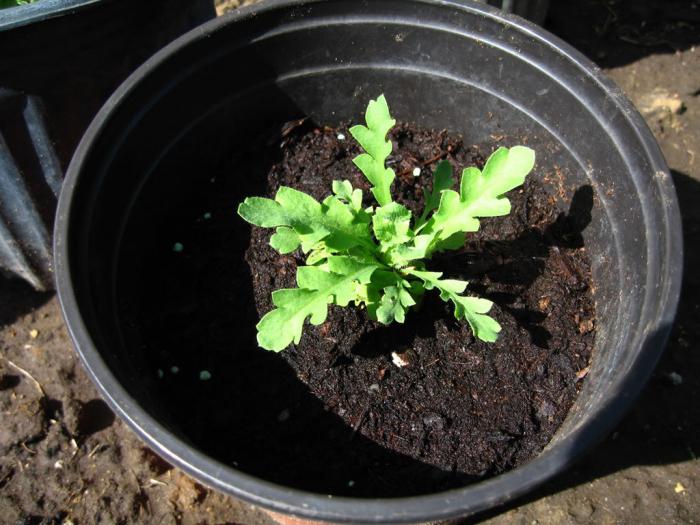

Flower bed care
Petunia reacts gratefully to feeding, therefore fertilizers are applied to the soil regularly, especially during the formation of buds and flowering. In the early stages, nitrogen fertilizers are preferred, which stimulate plant growth. When the petunia is about to bloom, it is fed with fertilizers containing phosphorus or potassium. They also regularly carry out foliar feeding with various complex fertilizers. For adult plantings, the optimal frequency of fertilization will be once every 5 days, with alternating root and foliar methods.
Despite the fact that growing petunia seedlings is a rather troublesome business that requires compliance with many conditions, it was and remains one of the most popular plants for the formation of backyard beds, decorating window sills. Bright, delicate flowers will reward everyone who dares to go through the seedling test with their abundant and beautiful flowering.
Picking seedlings is another crucial step
When the sprouts become larger, and you can hold them with your fingers, proceed to the next stage of growing petunias - picking the seedlings. How to sow petunia for seedlings, we have already studied in detail, but what is a pick? Not every novice gardener is familiar with this term. A pick is a transplant of seedlings. In our case, the petunia must be transplanted into open ground, most likely on a flower bed. How to grow petunia seedlings already in a flower bed? Take a special small spatula or even a regular toothpick and loosen the soil a little by pinching the roots of the seedling with your fingers. Carefully place the sprout in a very small hole and cover with soil.Water lightly, the soil should settle. Note that pinching is only necessary for those seedlings that are marked by strong growth. It is not necessary to deeply deepen the flower during transplantation, the deepening should be at the level of the first leaves and nothing more. Planting petunias for seedlings and growing them is not an easy matter, but if all the rules are followed, even a beginner can handle it.
Growing and care features
Experienced growers give advice on growing petunia seedlings from seeds. Be sure to buy high-quality, not expired seed, otherwise all efforts will be in vain.
Temperature
At the first stage, the room should be warm, but not hot: about + 23 ° С. After the appearance of two or three leaves, the indicators are reduced to + 18 ° C ... + 20 ° C. You can not accustom seedlings to greenhouse conditions: Before moving into the ground, be sure to harden the plants in the fresh air.
Lighting and supplementary lighting
If the windows of the apartment face south, then the petunia is planted with seeds in early March. If good artificial lighting is possible, seeds can be sown already at the end of February. Windows on the north side - seedlings have been growing since the end of March. Petunia does not tolerate low light, dampness, dark rooms. Fluorescent lamps are useful when there is a lack of light.
Humidity and watering
Violation of indicators of the content of water vapor in the air and soil leads to root rot, the development of powdery mildew, gray and black rot, and root damage. It is better to water the seedlings weaker than to increase the liquid rate. The drainage layer is an obligatory element at the bottom of the container. It is important to make holes in plastic cups to allow excess water to drain off.
Water the seedlings of petunia as the surface of the soil dries up so that the deep layers are well saturated. Blackleg disease often develops precisely against the background of excessive watering. The optimal time to moisturize the substrate is the morning of a sunny day. After adding a portion of water, containers with seedlings should be on the window from a moderately sunny side so that moisture does not stagnate.
Petunia tolerates moderate soil moisture well; with a moisture deficit, flowers suffer less than more capricious plants. Owners who cannot water their flower beds or bright decor in other areas every day should pay attention to petunia.
Top dressing
The addition of organic matter and mineral fertilizers is allowed only after the appearance of two strong, real leaves, before transplanting flowers into open ground. Experienced growers advise to reduce the fertilizer rate by 2 times compared to the recommendations on the package, so as not to burn the roots. Petunia does not need frequent feeding: unpretentious flowers grow well without the frequent addition of mineral components. It is useful to use organic matter diluted with water.
On a note! Many growers advise to scatter washed, dried and crushed eggshells over the surface of the soil to protect against the "black leg" (stem decay in the zone of transition from the soil to the aboveground part). The natural product not only prevents plant rotting, but also fertilizes the soil.
Picking
The procedure is carried out when moving sprouts from a common container into individual pots. Removing the root tip improves the growth of the underground part, making this part of the petunia stronger and more powerful. A root that is too long takes up some of the nutrients and interferes with the active growth of the stem and buds.
After picking, it is important to carefully transfer the sprout to a new container, strengthen it with earth. It is not necessary to fill a young flower too much so that the seedlings do not squint when the root moves in the new soil.
Pinching
The operation is carried out if the sprout is too elongated, and instead of a lush bush there is an shoot that is much ahead of other flowers in height. Hybrid varieties in most cases do not pinch: the plants are forming correctly.
To pinch, you need nail scissors or just your fingers.The essence of the operation is to remove the upper part of the petunia, but do not touch the main two leaves from below. The pinching is carried out obliquely, closer to the previous leaflet. After the procedure, the green mass gains weight more actively, the young flower grows rapidly. It is useful to feed the petunia with organic substances (low concentration of the solution and a moderate amount of eggshells) or mineral fertilizers.
Growing seedlings in tablets
Peat tablets used for seedlings are very economical, safe, convenient. In addition, they improve the quality of seedlings. Many gardeners prefer this method of planting. It does not involve picking, peat contains a whole complex of vitamins that feed petunia. Seedlings of petunia tablets are a great option for beginners in gardening. How do you use these wonderful and convenient pills?
- Buy tablets with a diameter of 3.5-4.5 cm.
- Place them in special plastic cassettes and fill with water at room temperature.
- The tablets will swell and increase in size. They are ready to receive seeds.
- How to plant petunia seedlings in these peat tablets? Remove any water that has not been absorbed and use a toothpick to create a hole for the seeds.
- With the same toothpick or tweezers, place the seed in the peat, but shallowly.
- Cover the cassette with foil for fast germination conditions. Thus, you create a kind of mini-greenhouse for seedlings. Be sure to ventilate it every day by pushing or removing the film. Do not forget to remove condensation from the film and cassette walls. Failure to comply with this point threatens petunia with a disease called black leg.
- Now observe all the same conditions for favorable seed germination as when planting in the ground. How to grow petunia seedlings is described in detail above in this article.
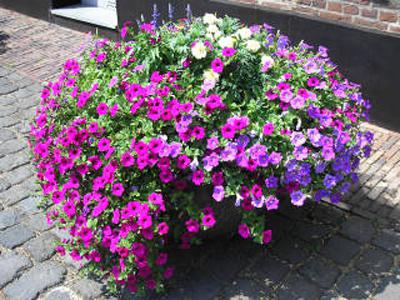

Peat tablets have a special mesh. Experienced gardeners advise removing it for faster seed germination and less stress when replanting. Remove the mesh using small scissors with great care.
Preparing petunia seeds for sowing seedlings at home
Seed processing stages:
etching. Reception is performed in order to prevent diseases. It can be carried out by soaking in hot water (50 degrees) for 30 minutes or soaking in a manganese solution; soaking. To speed up the germination process, the seeds are kept in warm water (25-30 degrees) in a saucer, covered with gauze. As soon as the seeds absorb moisture, add a little water again. There should not be too much water. As soon as the seeds hatch, they are dried and sown; processing with a solution of trace elements. This speeds up seed germination, seedling growth and increases disease resistance.
Conditions for growing petunias in the ground
When you are going to dive seedlings into open ground, pay attention to its quality and the location of the flower bed. Petunia loves light, so a flower bed in constant shade will not work for her. Choose a bright and sunny spot for your flowers. The soil should be loose and non-clayey. If you are going to transplant a flower into a pot, then the composition of the soil must be carefully selected. There must be turf, peat, sand and leafy, garden soil. The addition of perlite is also possible. It will give the soil additional looseness. Growing petunias in pots and pallets on balconies is immensely popular. The pot is easy to hide from wind, cold and rain. And flowers delight the hostess and passers-by all summer.
When to plant seeds: timing
The wrong choice of period negatively affects the strength and growth of the petunia. Do not plant seeds too early: the seedlings will stretch out, "overstay", but late sowing of the material will lead to a violation of the timing of moving the plants into the open ground.
Lunar calendar
Important nuances:
- seedlings are sown on the growing moon;
- during the new moon, a few days before and after it, seeds are not planted.
It is useful to buy a florist's lunar calendar annually with a full indication of the phases of the luminary, prohibited and permitted types of work for every day. Many growers claim: following the recommendations from the lunar calendar helps to get more lush, strong shoots and adult plants.
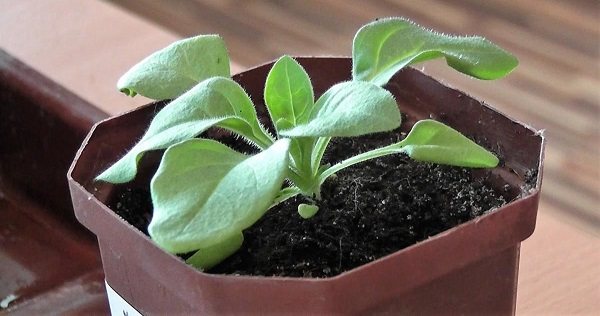

Depending on climate and region
An important nuance to pay attention to. Most varieties of petunias grow well in temperate areas, blooming until late autumn. With a short summer, frost-resistant varieties are chosen, for a temperate climate there are more varieties of spectacular plants.
For ground cover decor, flowerpots in the center of flower beds, various supports choose a cascading (spreading) petunia with long branching shoots up to 2 m long and large flowers - "gramophones". To decorate arches, walls of a house, gazebos, the apmel variety is more suitable: the length of the shoots is up to 1.5 m, the flowers are small, they can have different shades.
Manufacturers recommendations
On the packaging with seeds from the agricultural store, there are always tips on the optimal growing regime for a particular variety. The timing of planting in the ground, the flowering period, disease resistance are important characteristics that you need to pay attention to. Before planting petunias, you need to revise several options for seed, check with sales consultants, neighbors in the country, familiar florists, which varieties they recommend, taking into account the quality of the seeds and the characteristics of a particular variety.
Are there special conditions for growing petunias in the ground?
The greatest danger to growing petunias outdoors is wind and rain. They are able to provoke the termination of the flowering of the plant. Petunia can also stop blooming in cold weather.
Caring for petunia is not particularly difficult, the main thing is to cut vertical shoots in time for beautiful branching of the plant and remove dried flowers to form new buds.
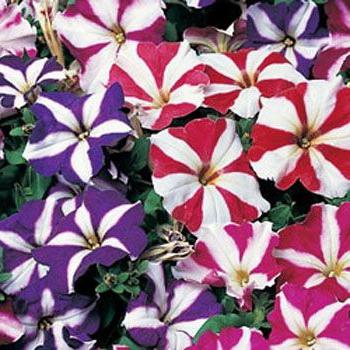

Rules for planting adult seedlings in a flower bed
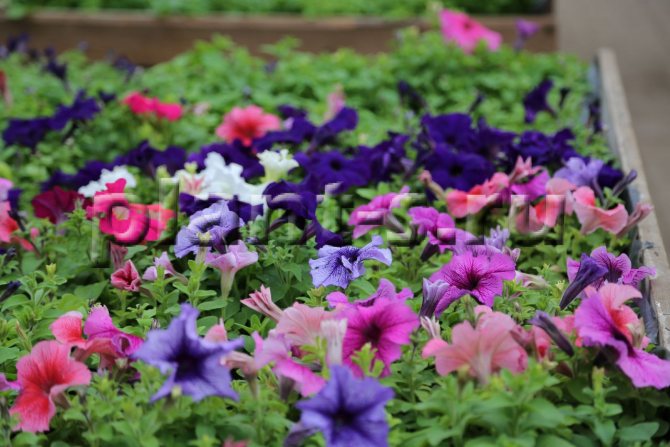

Seedling petunia
- Petunias are very photophilous, so it is better to equip a flowerbed for them in an open place, where the sun is often.
- Preference should be given to light, loose, clay-free soil.
- Petunias are very sensitive to wind and rain. Therefore, when choosing a place for planting seedlings, care should be taken to protect the flowers as much as possible.
- Before planting adult seedlings in a flower bed, the plants must be hardened, taking them out into the fresh air for a few minutes first. The hardening time is gradually increased to several hours.
- After stable, warm, good weather is established, around the second decade of May, the seedlings are transplanted to a prepared place.
This can be done only after the end of the night frosts, since petunia is very thermophilic and sensitive to cold.
- The distance between the planted plants should be approximately 15-20 cm for multi-flowered varieties and 20-25 for bush varieties. If you plant petunia seedlings too often, the plants will interfere with each other and will not be able to grow fully.
- Cloudy weather is better suited for disembarkation, especially if the work will be carried out in the morning. In this case, the seedlings weakened by the transplant will not suffer from the bright sun. It is best to schedule boarding for the evening.
- After all the petunia bushes are planted, the flower bed is watered with settled water and the ground around the flowers is mulched.
The mulch can be peat or matured compost. This procedure will protect the soil from drying out too quickly, and the fragile roots of a young plant from possible night frosts.
Does petunia need feeding?
In principle, petunia does well without additional feeding. But if you want to see especially lush and beautiful flowers on your site, then you cannot do without feeding. In order for petunia to bloom luxuriantly and for a long time, use the most common fertilizers based on a full complex of minerals.Twice a month it is required to apply a portion of fertilizer to the soil. The main thing that you should pay attention to when fertilizing petunias on the site is the impossibility of using manure for feeding.
Some experienced gardeners who love petunia advise beginners on a special course of feeding it. In the first week after transplanting, you need to fertilize the plant with a solution of water and humates. In the second week, water the petunia with a solution of water and potassium sulfate. Then alternate according to the scheme. Such a course will delight you with excellent results.
Properly cared for petunia blooms in Russian gardens from May to autumn. She pleases all people with the beauty and richness of the palette. How to plant petunias for seedlings, we examined in detail in this article. Try it and you will definitely succeed!
Moon calendar
It is unlikely that any of the gardeners have heard anything about the lunar sowing calendar. Many do all the work associated with growing flowers, be sure to check with his recommendations. It has nothing to do with horoscopes and other predictions - it simply takes into account the influence of the celestial body closest to us on the processes taking place on Earth.
It is known that annuals planted in the day, closest to the full moon and new moon, do not grow well and take root... Such days are considered unfavorable for sowing. There are also neutral days and days in which the likelihood of active growth is highest. It is necessary to be guided by them, choosing the time not only for sowing seeds, but also for diving seedlings, their transplanting and planting in a permanent place. As a last resort, you can do this on neutral days, and avoid unfavorable ones.
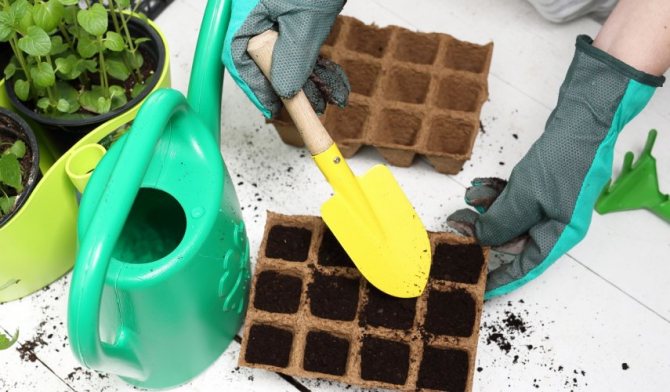

For landing, you should choose the most favorable day.
These dates change every year, since the phases of the moon do not coincide with the number of calendar days in a year. Let us give Lunar calendar for sowing petunia for the next season: from December 2018 to April 2019.
On a note. You can sow petunias at home for seedlings at any time. Planted in December, by the end of winter they will delight you with lush and bright flowers on an insulated loggia or in a winter garden.
| Month of the year | Auspicious days | Bad days |
| December | 3, 5, 9, 11, 12, 27, 31 | 2, 4, 7, 8, 10, 17, 18, 19, 21, 22, 23, 26 |
| January | 10, 11, 15, 16, 17, 18, 19, 20 | 5, 6, 7, 8, 9, 22 |
| February | 6, 7, 8, 12, 13, 14, 15, 16, 17 | 3, 4, 5, 11, 18, 20 |
| March | 7, 10, 11, 12, 14, 15, 16, 19, 20, 21 | 3, 4, 5, 6, 13, 18, 22, 30, 31 |
| April | 7, 8, 9, 10, 11, 16, 17, 18, 19 | 1, 5, 12, 13, 14, 15, 21, 27, 28 |
Dates not listed in the table are considered neutral.
Video - Growing petunias from seeds
Florist tips
- When preparing the soil for seedlings, it is worth adding a hydrogel to it. This will help the petunias fight excess or lack of moisture. If the hydrogel is soaked in a fertilizer solution, there will be a double benefit.
- When buying in a store, the soil may not be of high quality. The purchased soil must be disinfected. And for better germination of seeds on the surface of the prepared soil, it is necessary to crumble a peat tablet.
- Petunia is a very light-loving plant, you must definitely take care of good lighting.
- Petunia responds well to fertilizers. It is necessary to very carefully feed.
Different ways of growing
It will take 90 days to grow a full-fledged petunia seedling. Each grower has its own proven growing method:
- sowing in a box (pots) filled with soil;
- using peat tablets;
- on toilet paper.
In peat tablets
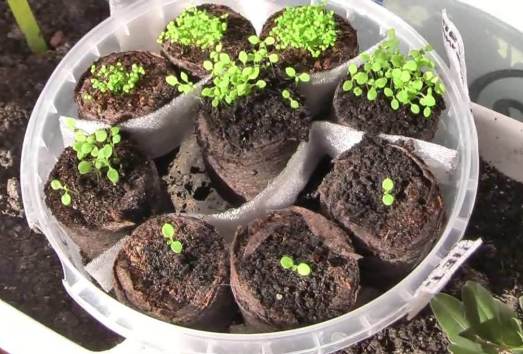

You can buy peat tablets at any supermarket. The seeding procedure is simple:
- the tablets are first soaked in water;
- after they increase in size, they are placed in a box (container) with sides of at least 4 cm;
- the seeds are placed in the indentations on the tablet;
- the box is covered with foil.
Shoots appear in a week. Before they appear, the tablets must be moistened.
In pots, in pots
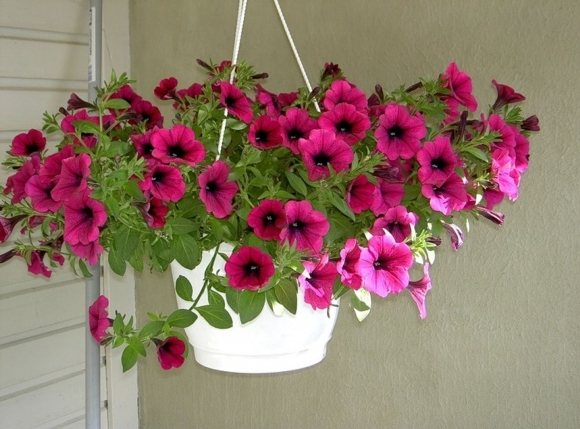

To decorate a balcony or loggia, petunias are sown directly into a pot or pots. The success of a lush bloom will depend on the correct potting mix. For decorativeness, petunias of various types (bush, ampelous) are planted in one container and supplemented with other flowers: alissum, lobelia.To maintain the soil in the pots in a moist state, a hydrogel or vermiculite is added to the soil.
Choosing seeds
Good seedlings will only work if high quality seeds were used when planting. An adult plant must meet all the characteristics of a particular variety. That is, the flower must have the size and color characteristic of the given variety, be somewhat resistant to growing conditions, etc.
You can plant petunia with two types of seeds:
- coated;
- clean.
The casing offers a number of advantages: the seeds are protected from damage and disease, and they are easier to sow into the soil. Pure seeds, devoid of a shell, are much cheaper and if the petunia is sown correctly, germination will be high. Marking allows you to recognize the variety of flowers.
Correct sowing of petunia - from "A" to "Z"
The prepared soil must be moistened, after which petunia seeds are sown on it. It is not necessary to sprinkle the sown material with soil; it is enough to slightly press it down.
The question may arise: how to sow petunia evenly, because the seeds are very small? The task is simplified by mixing seeds with sand in a ratio of 1: 5. Immediately after sowing, the soil is spilled with a solution of Previcur (0.1%) to protect the sprouts from fungus. In order not to wash out small seeds, you need to disinfect the soil by watering through a fine strainer.
Until the emergence of seedlings, containers with plantings are covered with glass or a piece of polycarbonate. Water the soil, if necessary, using a spray bottle.
The first shoots appear on the 5th day. Dense plantings need to be thinned out, for which extra seedlings are plucked out.
For the normal growth of petunia seedlings, a temperature of 20-22 degrees is required. With the emergence of petunia shoots, the shelter is removed and the containers are transferred to a room where the temperature does not exceed 18 degrees.
If the petunia is sown correctly and optimal conditions for the growth of seedlings are created, after 3 weeks the grown seedlings can be dived.
Seedlings are dived into flower pots 3 weeks after the first transplant. The diameter of the pot should be 8-10 cm; a substrate rich in micro- and macroelements is used as soil. The transplanted plants are taken out in a room with a temperature of 20 degrees during the day and 18 at night, then the temperature must be lowered by another 4 degrees.
Sowing in granules?
Many expensive petunias are sold in pellets. How to sow petunia correctly in this case? In a box with soil, you need to cut shallow grooves, shed them well and put strips cut from paper napkins. Seeds in granules are gently spread on damp strips. They will not be lost as they reliably adhere to damp paper. As with sowing with clean seeds, you do not need to sprinkle the granules with soil. Crops must be spilled through a spray bottle, the boxes are covered with foil and left in a warm place until shoots appear.
The germination period of petunia in granules is slightly longer - 10-20 days when supplemented with a fluorescent lamp. It is important that the emerging seedlings immediately receive enough light to prevent them from stretching.
With the formation of the first true leaf, the crops of petunia are aired, the film is removed and the temperature is lowered to 16 degrees. When the third leaf appears, the seedlings are thinned out, planting excess plants. You need to know how to properly plant and care for petunia. Waterlogging of the soil in plantings should not be allowed - watering is carried out every 3 days, as the soil slightly dries out. This mode stimulates the development of the root system, and the seedlings are more viable. The grown plants are pinched, because of which the petunia begins to branch. If the petunia is sown early, the apical part can be rooted.
Abundant flowering of petunias can be achieved if certain conditions are met: the pot must be of a suitable size, the timeliness of watering and dressing, the removal of wilted flowers.
When to sow pepper? - read in our next article!
Video: growing petunia seedlings from seeds
In wildlife, there are more than 25 species of petunias. The most popular among florists are hybrids. They grow a bright flower in city parks, in the country, on a loggia or balcony. The flower is not picky and grows well both in a flower bed and in the form of a potted culture.
How to properly plant in open ground and care for petunia
The beautiful plant belongs to the nightshade family, its homeland is South America. The flowers are like the trumpet of a gramophone. She is a favorite with landscaping gardeners and one of the most grown plant. Planting takes place through seedlings, this will allow you to monitor the timing of flowering. Planting and caring for petunias in the open field does not require special gardening knowledge as it might seem at the beginning. The most novice gardener can engage in its cultivation, but a carpet of blooming petunias will look fascinating on the site.
Outdoor planting
In fact, perennial petunia is grown as an annual plant with a height of 50cm. Petunia varieties are divided into small and large-flowered, differing in terms of flowering. To plant petunias in open ground, you need to choose a sunny area so that the night cold passes and warm nights are established. She loves the warmth of the sun, but the direct hit of the sun on the petals of the plant spoils the appearance of the plant. The plant breaks down from gusts of wind, therefore, it is planted in places covering it from it. Suitable soil for petunias is loamy or sandy loam.
The existing soil can be corrected:
- Poor soil - with the help of introduced humus or compost, it is fertilized;
- Unstructured soil - sand mixed with peat is introduced;
- Sour soil - improve with lime.
A good quality of the plant is that it can tolerate dry soil, but it is better if the soil is moisture-absorbing, structural and loose soil is the most suitable option for growing petunias. The timing of planting bushes in open ground depends on weather conditions with rain and wind, this should not be done. If warm weather is observed at the end of May, then you can safely plant, and cold-resistant hybrids are planted even earlier.
For landscape design, different varieties are selected and planted in a planned order, making distances of 20 cm and 30 cm between them for large ampel varieties.
Preparation of planting material
It is possible to grow a plant with seedlings, planting seeds in February. Before planting, the soil is prepared and sterilized; for seed germination, the soil must be drainage and not acidic. There is no need for special devices for this, it is enough to place the soil in the microwave for 10 minutes.
If ready-made seedlings are planted, then a pot or a special meter box for such plants is taken and no more than three bushes are planted, do not worry petunia will grow quickly. So they are planted so that the powerful root system of the plant does not muffle other weaker bushes. By adhering to the correct planting instructions, the plant will take root better and faster.
How to plant petunia in open ground
Before planting, they choose a place where it will grow, having decided on it, they start planting:
- It is better to plant petunias in the morning and in good weather;
- Take the bush together with a lump of soil;
- They are planted to a depth of half a palm, about ten centimeters;
- Large varieties of plants are planted at a distance of 30 cm from each other;
- After planting, the flowers are watered with nitrogen fertilizer.
It is necessary to monitor the seedlings, diseases, especially the "black leg", easily appear on them, in order to minimize the manifestation of diseases, the soil should not be waterlogged and too dry. Spraying seedlings is carried out with a solution of potassium permanganate, this will prevent the spread of the disease. The first shoots of seedlings appear on the 14th day. Seedlings are transplanted when there are four leaves on it.
You can also plant petunia seeds.In late spring, with well-established weather, the seeds are laid out in the open ground and watered. They grow slower than seedlings, are sensitive to watering and fertilization. If they have taken root, then at the end of June you can see a flowering plant.
Petunia will bloom until early October. If the seeds are grown in a pot, then you need to cover it with glass or cling film.
To grow plants in pots and containers, you need special soil:
- Sod land;
- Sheet;
- Peat;
- Sand.
Expanded clay or perlite is added to inter-soil looseness. Also, land can be purchased at a flower shop.
Care
Petunia loves grooming and, in return, pleases the eye with its abundant flowering. Having made the first pick of the seedlings and when the first leaves appear, the plant must be fed. To do this, use:
- For petunia to grow well, you need nitrogen;
- For buds - phosphorus and potassium.
- Foliar dressing is carried out with fertilizers with microelements;
- For a beautiful look, petunias need iron;
- The plant is also very fond of potassium monophosphate.
They also use mullein for fertilization, which was infused before. The plant has not whimsical watering requirements, it is drought-resistant, can tolerate high humidity for a long time, and stops flowering with heavy rainfall. Resistant to cold weather, top dressing is done every 20 days. With proper care, the plant does not get sick, so it is advisable not to overdo it with watering and feeding. The plant needs to be weeded periodically, so the plant is cleared of weeds and gets air access. In inclement weather, pots, pots are brought into the room so that the plants are not damaged.
Tip: In order for the plant to be healthy, you need to check it periodically. Scan for pests and diseases. Spray the whole plant with special substances from below and above, separate damaged and faded flowers.
Classification
In the classification of the plant, 7 groups are distinguished:
- Grandiflora;
- Grandiflora Superbissima;
- Grandflora fimbriata;
- Grandiflora captivity;
- Multiflora;
- Multiflora captivity;
- Nana compact.
Despite the "royal" names, petunias are rather unpretentious. Their height ranges from 40-60 cm, the diameter of the flower is from 7-12 cm. Various colors, flowers are double-velvety, wavy.
It is not for nothing that petunia has always been in demand by gardeners. Without paying special attention, the plant gives its owners a long and lush flowering until the very cold weather. Try to plant this miracle on your plot or balcony in the spring.
Advice:
- It is advisable to grow bushes of the same growth and development in the same container;
- It is not recommended to combine plants with different flowering periods;
- Plant the same type of bushes in one pot;
- Do not repot the plant too often;
- It is possible to combine four types of petunias;
- It is necessary to plant flowers in a hanging planter in a symmetrical order;
- I place larger seedlings in the middle of the pot, and undersized species along the edges;
For designer performance, it is better to use white pots or pots, so the variety of plant colors will attract even more attention. Planting petunias in open ground and leaving is not a very difficult task that takes a little time.
cvety-na-
When and how to plant petunia outdoors
I have already told you how I naively sowed petunia seeds in the ground, but for some reason they did not sprout. It turned out that these "guys" are very small, and the sprouts that break through from them are too weak to break through the soil layer poured over the seeds.
Therefore, they need to be germinated only on wet soil, without deepening. And to propagate petunias is a seedling method. But here on your windowsill fresh and juicy seedlings turn green, it's warm outside, and your soul asks to transfer all this beauty closer to your neighbors' eyes (let them envy). What is the right thing to do?
We "resettle" the seedlings into permanent soil
Earlier, I already said that seedlings in pots need to be dived twice, that is, transferred into the ground fresher and a larger "house" (of course, if you did not grow them in peat tablets, in this case, a dive is not needed).
This is done in May - early June.
If this is a flower bed (for bush varieties), it needs to be prepared a little:
- Dig up the ground - well, it goes without saying.
- Fertilize the soil. Do not save peat or humus, if food is scarce, petunia will skimp on flowers. You can also season this "food" for flowers with ash (a shovel of ash is added to a bucket of humus). Well, if the ground is acidic, add lime.
- Mark the places for the holes. This is done based on the size of the inflorescences: small flowers can be planted after 20 or even 15 cm, and large ones - no less than 25 cm.To make the rows of flowering bushes as slender as possible, help yourself with pegs and a cord. Round flower beds are no less successful.
- And remember: petunia loves the sun. Rare varieties feel fine in partial shade, but the plant does not like thick shade at all. Therefore, choose a completely open area. Although, of course, in the first three days after transplanting, the flowers can be shaded a little so that they can more easily take root in a new place.
The sprouts need to be hardened in advance, every day (from a week) taking them out into the open air for 15 minutes, and leaving them for a day before planting.
Next, your actions:
- Choose a free evening or at least a day when the sun is completely covered by clouds - this is the most favorable time for replanting. If it's hot outside, be sure to wait for the evening: a flower transplanted during the heat may not take root, since the sun will have time to dry out both the soil and its root system.
- Water the potted seedlings to soften the soil between the roots.
- Transplant flowers using the transhipment method. Their roots are very fragile and there are many of them, so be as careful as possible and do not put sharp objects in the pot - if the root does not come out, it is better to tilt the container and tap it slightly.
- Immediately transfer the sprouts to their own hole and dig in their roots with earth.
- Water the flower bed. The soil around the flowers can be covered with peat. This will kill a few birds with one stone: and add the nutrients to the flower that he simply adores, and help the earth to retain moisture inside for longer. Humus is also suitable as mulch - although, of course, not everyone will want to lay it out in their yard.
Plant care
- Spraying. Even if the plant blooms in a flower bed, in the heat, pamper it with additional moisture from a spray bottle. If the summer is more than sunny, you can spray your pets every day, morning and evening.
- Watering. You need it frequent, but strictly dosed - you don't need puddles near flowers, so do not overdo it.
- Safety. Do not “wash” the flowers from the watering can - give water to the root, as many varieties are afraid of it (and not only flowers, but also leaves). Because of this fear, even some petunias growing in pots have to be carried under shelter during the rain ... To prevent this from happening, plant only non-capricious varieties that are not afraid of precipitation in pots and balcony boxes. Also remember: many ampelous (with shoots hanging down) varieties are afraid of the wind, so place pots with them in cozy corners.
- Feeding. You can remember about it once every 7 days, one week by applying fertilizer with the root, and the second - by the foliar method. How long to feed the flower? Until it blooms completely. You can buy potash fertilizers. Organic will also do.
- Purchased stimulation products. They will help the plant bloom brighter, bush more actively and delight you even more. They do not need to be brought in just like that - but if the weather conditions are not the best and the petunia is in no hurry to cover itself with a million flowers, buy Epin-extra or Zircon.
It is better to remove faded flowers, as well as sluggish branches in time - this way the bushes will look even more elegant.
Is it possible to sow seeds directly
Yes! Although I did not manage to grow petunia this way, many gardeners do it. This is done at the end of May.
The germination of seeds is proved by at least the fact that the flower beds, on which last year the petunias bloomed and which you did not have time to dig up in the spring, are covered with rare, but still sprouts of these flowers in June.
Here's what experienced flower growers told me:
- The earth needs to be dug up to be loosened. Of course, give fertilizer too.
- The seeds cannot be buried, they are simply scattered over the ground. Do not cover them with soil at all (especially, you cannot sprinkle and tamp them).
Such a plant will bloom 2-3 weeks later than the seedling. But at the end of June, you will already see the beautiful fruits of your hands.
By the way, such seeds are sown in pots earlier than in open ground. Moreover, you can also arrange a planted or sown flower like this: Remind you how to grow petunia seedlings, you can use this video:
Sowing preparation
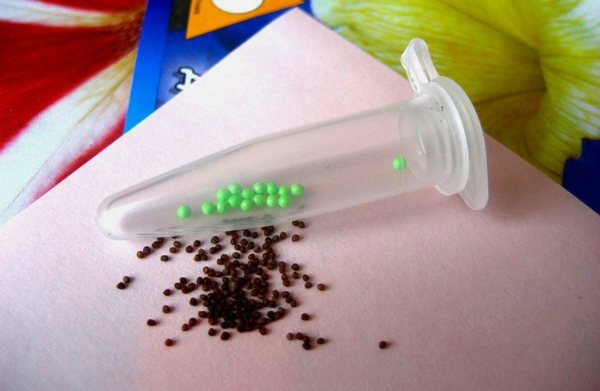

Seed selection
Seeds for sowing can be bought in a specialized store, or you can leave a few flowers from the past until the full ripening of the year and collect them yourself. You just need to know for sure that the selected plant is not hybrid, since the seeds of the hybrids can inherit the variety of one of their "parents" and the flower will not grow as expected.
So, it was decided to collect the seeds on our own, for this they select several lower flowers, mark them with a bright thick thread and these flowers are no longer removed after they have faded. It takes about two months from the full opening of the flower to the formation of seeds.
Seeds form in capsules, and there is a chance that the picking moment will be missed and the seeds may simply spill out onto the ground. To prevent this from happening, you can put a bag of disposable tea on the box and then the seeds will certainly be collected on time.
Requirements for soil mixture
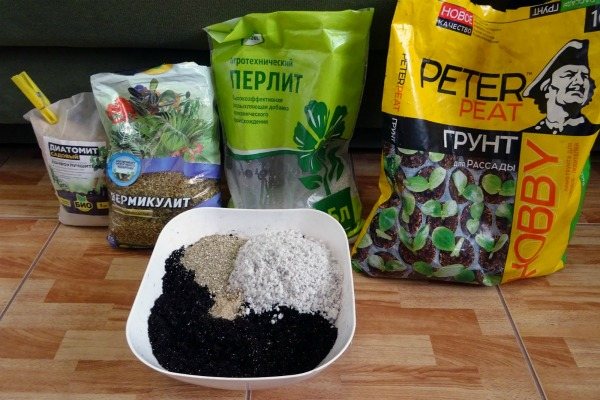

The soil can be either store-bought or prepared in the fall on its own, the main thing is that it is present
- Turf;
- Humus;
- Peat;
- Sand.
All components must be taken in equal parts.
If the soil is acidic, add lime.
Whichever soil is used, it must be disinfected before use. Spill with potassium permanganate solution. And also spill with boiling water or ignite in the oven.
Seed preparation for sowing
The seeds need to be stratified. To do this, the seeds must be mixed with sifted river sand, put in a paper bag or box, wrapped in cellophane and placed in the refrigerator for one and a half to two months.
When sowing seeds "in the snow", this operation can be skipped.
To increase germination, you can soak the seeds in a weak solution of potassium permanganate or epin 10-12 hours before planting.
Important! If the seeds are sown, focusing on the lunar calendar, then the day the seeds are soaked will be considered an auspicious day.
Petunia species
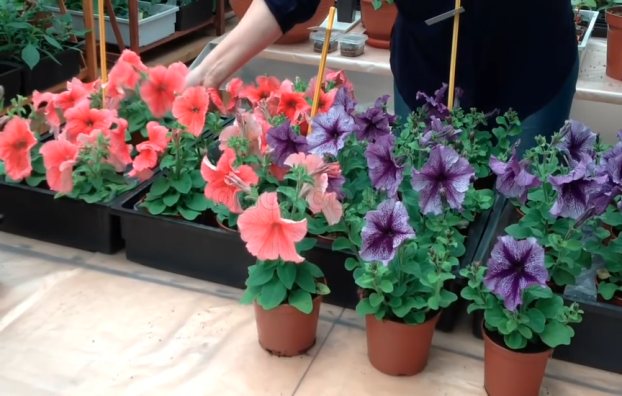

There is no consensus among flower growers about the classification of petunias. Usually, this type of ornamental plants is divided according to the following characteristics:
- bush shape;
- the size of the flower and the type of flowering.
By the shape of the bush
Depending on the shape of the bush, varieties of petunias are distinguished: bush, cascading, ampelous. Consider what are bush types of petunias. They are low-growing, compact, with erect shoots up to 30 cm long and tall species with spreading shoots from 50 to 75 cm long. Varieties and bush-type hybrids do not need to be formed. To simulate the growth of side shoots, you just need to pinch the growing point.
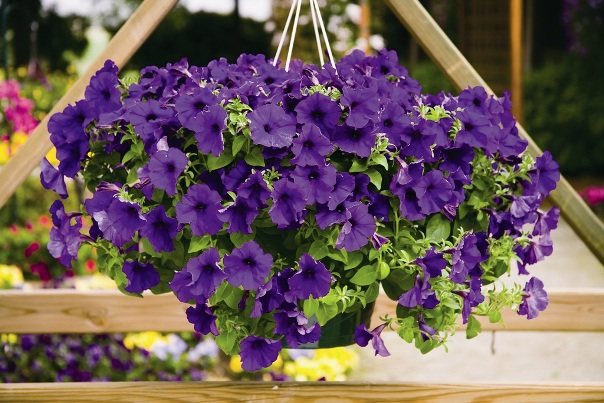

The ampel group of petunias combines plants with long shoots from 50 to 150 cm long. They are characterized by:
- fast growth of shoots;
- long and abundant flowering;
- resistance to adverse weather conditions.
Ampel varieties of petunias look good in hanging pots. Landscape designers use this kind of flower with thin, long lashes for vertical landscaping.They practice planting ampelous petunias in the ground to obtain bright floral carpets.
Cascading petunias have thicker shoots, the length of which is shorter than that of the ampelous varieties. They grow to the top, they go down only when they reach a certain length. Varieties and hybrids of cascading petunias are used to decorate loggias and balconies. Their seedlings are planted in boxes, pots, pots.
By flower size and flowering type
All petunias are divided into two groups by flower size:
- P. small-flowered;
- P. large-flowered;
- P. blooming profusely;
- P. multiflorous.
Small-flowered
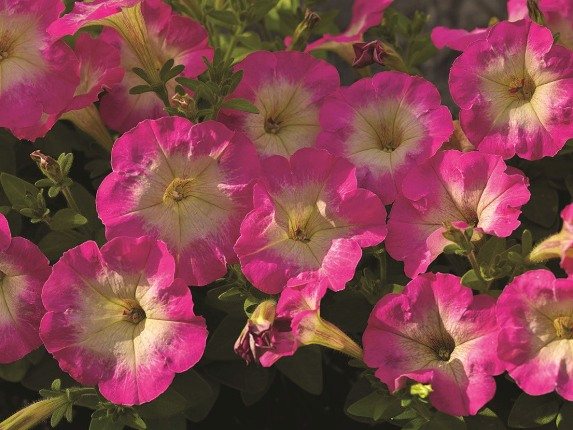

The Milliflora group of small-flowered petunias combines plants with a flower diameter of 2.5 to 3 cm. This species is distinguished by abundant flowering, rain does not affect their decorative effect. Bushes are formed from numerous branched shoots up to 0.9 m long and erect stems not exceeding 25 cm in height.
Florists use varieties when creating flower arrangements:
- Pink F1;
- Yellow duck F1;
- Picobella (series).
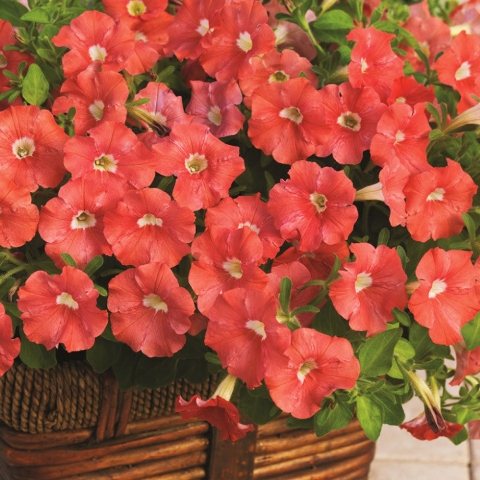

Petunia Picobella Cascade (Salmon / Salmon)
Large-flowered
Large-flowered forms do not tolerate difficult weather conditions. The flowers of these forms are very decorative, but the number of flowers on the bushes is less than that of small-flowered species. The large-flowered group of petunias - Grandiflora - is popular among flower growers.
It combines low-growing varieties with a stem height of 25 to 35 cm and tall ones with a shoot length of 50 to 70 cm. Flowers are large in different shapes: simple funnel-shaped, double. The diameter of the flowers can range from 8 to 13 cm. The flower petals have solid, wavy or corrugated edges.
Popular variety series of large-flowered petunias:
- Double Cascade F1;
- Galaxy F1;
- Black velvet;
- Spherical F1;
- Sophistry F
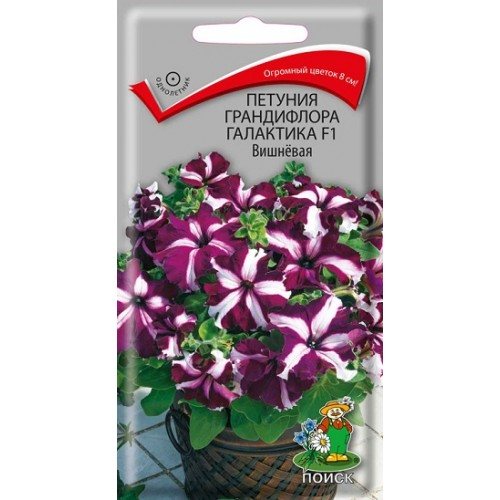

Blooming profusely
Floribunda is a group of hybrids and varieties that brings together abundantly flowering petunias. The height of erect, branched shoots is from 25 to 45 cm. The flowers are simple funnel-shaped or double with a diameter of 6 to 10 cm. This type of petunias is used in the decoration of flower beds and borders. Popular varieties of petunia Floribunda:
- Sonya F1
- Milky Way F1
- Angora F1
Multi-flowered
The multiflora group of multiflora petunias consists of dwarf, compact plants, abundantly strewn with flowers. The height of the bushes does not exceed 25 cm. The shape of the flowers is different - from simple to double, the diameter of which does not exceed 5 cm. The flowering of multi-flowered petunias is early and long-lasting. Plants of this group are used when decorating flower beds, balconies, and grown indoors on window sills.
Varieties common among flower growers:
- Celebrity F1;
- Pikoti F1;
- Glafira.
How to properly plant petunia seedlings
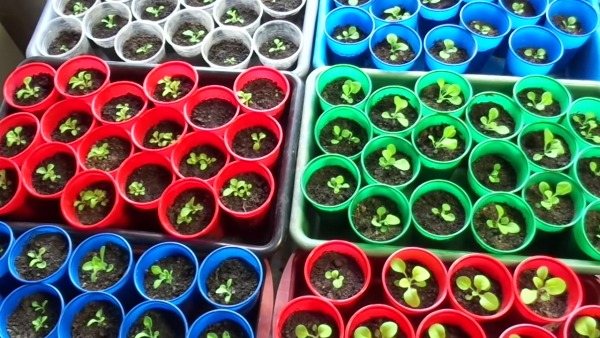

There are many ways to plant petunia seeds.
In cassettes
Cassettes are sold in different sizes. There are cassettes in which peat is already present. For petunias, a cassette with a diameter of 10 cm is suitable. Seeds can be planted both in peat and simply in the ground.
Into containers
As a container, you can use both special purchased containers and those made from scrap materials. It can be:
- Mayonnaise jars;
- Sour cream;
- Baby food.
- Cake container;
- Disposable plastic containers.
The prepared container is filled with soil and petunia is sown.
The seeds of petunia are very small, so they are simply scattered over moistened soil and covered with a lid or glass.
In peat tablets - video
Into the snow
The method of planting petunias "in the snow" is very interesting.
Prepared soil is poured into containers or cassettes and a layer of snow of about 5 cm is placed on top of it. The seeds are simply scattered over the snow.
The seeds of the petunia are black and will be clearly visible on the white snow. If it turns out to be very thick somewhere, then you can easily thin out with a toothpick. The melting snow will drag the seeds to the depth required for good germination.In addition, seeds sown in this way undergo stratification, which has a positive effect on their further growth.
After the seeds have been sown, the container is closed with a lid or glass and placed in a warm but bright place, since petunia is a light-borne plant.
With sand
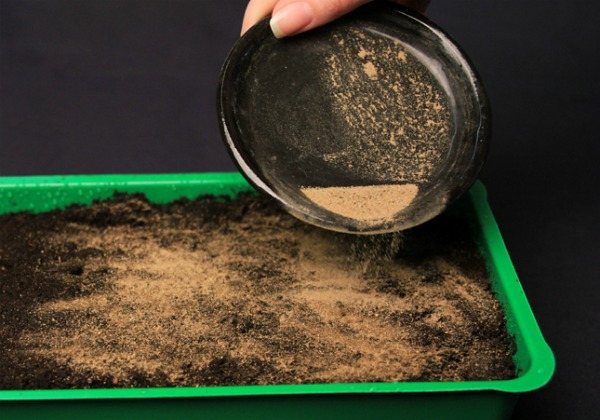

- The seeds of petunia are very small, so that it is more convenient to sow them, they are mixed with fine river sifted sand.
- The resulting mixture is scattered over the moistened soil, thus achieving a more rare and even sowing of small seeds.
- Then they are also covered with glass or foil and placed in a warm, bright place.
Into a snail
A new but very rapidly spreading method of planting seedlings.
- You need to take a rectangular tape from the backing under the laminate one meter by ten centimeters.
- Pour the soil onto the substrate with a layer of 2 cm and gently roll it up with a snail.
- Secure with tape and place in a suitable container.
- When the snail is installed vertically, the soil will settle down a little, you need to add to the top and water it with water.
- Scatter petunia seeds on the surface, cover with a plastic bag and put in a warm, bright place.
This method is good because the seedlings do not stretch, but build up the root system. And it is very convenient to dive plants: just unfold the snail and, without injuring, remove the seedling.
Important! The soil in the snail dries out more slowly, and therefore it is often not necessary to water the seedlings.
Sowing in a snail - video
Into boiling water
Petunia seeds planted in boiling water germinate faster. This is due to the fact that the etheric shell of the seed is destroyed under the influence of heat and germination occurs faster.
- It is necessary to fill the prepared containers with soil and pour over boiling water, place the seeds on the surface of the soil immediately.
- Then cover the planting with a lid or glass and place in a warm place.
- If possible, then on the heating radiator for 1 hour, and then in a warm, bright place and wait for shoots as in a normal planting.
On toilet paper
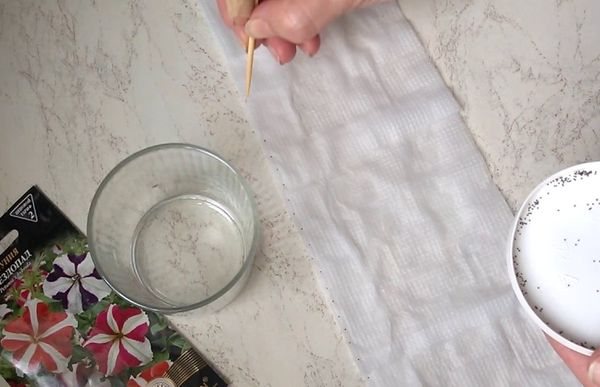

There are two ways to plant a petunia on toilet paper.
Method 1: "In Moscow" or twisted.
- You need to take a rectangle of dense polyethylene, lay toilet paper in several layers on top of it.
- Moisten it thoroughly and spread the petunia seeds at a distance of 1-2 cm from the edge of the paper, the distance between the seeds should be at least 3-4 cm.
- On top of the decomposed seeds, lay another layer of toilet paper, if necessary, gently moisten it, and begin to roll it up.
- At the end, the roll is secured with an elastic band or tape and placed in a plastic cup. Pour 3-4 cm of water at the bottom of the glass. The seeds should be up and not touching the water in any way.
Each variety must be stirred on a separate twist. So in one glass you can grow seedlings of several varieties of petunias. A glass with rolls is placed in a plastic bag and tied. Thus, we got another type of mini-greenhouse.
When the first shoots appear, it is necessary to begin to gradually ventilate the greenhouse. And after a week you can no longer close it. All this time, plants need good illumination.
There is no need to add water, but it should be changed every 3-4 days. After the roots of the plant reach the water, then here it will be necessary to ensure that there is always life-giving moisture in the glass.
Method 2: On toilet paper in a bottle.
You can grow petunia seedlings on toilet paper in a bottle.
Cut the bottle lengthwise into two halves. One will be the base of the bed, with the help of the second, a kind of greenhouse will turn out, the whole structure is held in place by a twisting lid.
You need to take several layers of toilet paper and cut into small noodles. Place in the bottom of the bottle and moisturize thoroughly. Place seeds on top and close with the second part of the bottle. Place the bottle in a transparent bag and put away in a warm place. It remains only to wait for the shoots.
Petunia on the balcony - planting and care
It remains to figure out how to grow petunia on the balcony with your own efforts.
It is worth growing seedlings in the main way. To plant on the balcony with the onset of warmth without the threat of frost, somewhere from mid-April. Before planting, you need to harden the seedlings, regularly exposing the seedlings to the balcony. First, by 5-10 minutes, gradually increasing the time.
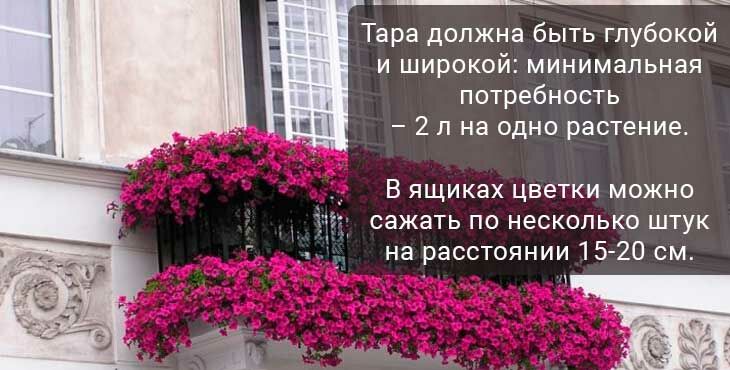

Petunias of the cascade and ampel type need more feeding, so the containers should be larger: from 3 to 5 liters of soil per plant. For especially large varieties Typhoon and Tornado, the recommended volume of land is from 7 to 10 liters.
The plant is rightfully called the queen of balconies. Indeed, from this flower it is so easy to create real compositions of different colors, combining different shapes. How do I create a pattern? Use benches, ladders, and hang in pots on the railing.
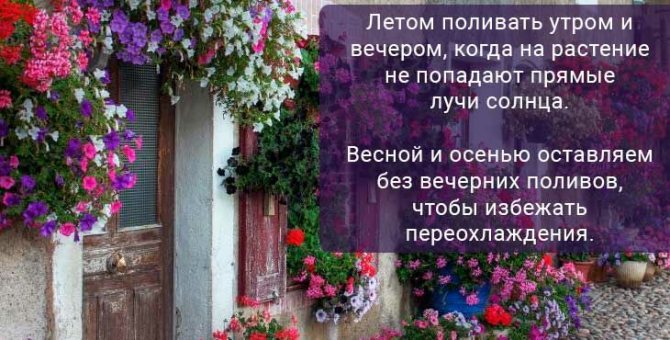

Did you like the article? I really want her to inspire you to grow these flowers! Tell your friends about the topic of our conversation. And the best way to do this would be a social media link to my site.
Gardeners' recommendations
Gardeners, when asked how to plant petunia, advise using 15-liter pots, 4 pieces each. But they do not recommend this amount for the Tornado variety, no more than 3 of them are better. If you periodically remove wilted flowers, seed pods and fertilize a few over the summer, then it will have a very beautiful shape all season.
Many people recommend planting petunia together with tall flowers. And some use it as a monoculture in a flower bed. Both options will look very nice.
I advise you to water once a day, but avoid stagnation of water. Otherwise, the flower may die.
Description of petunia
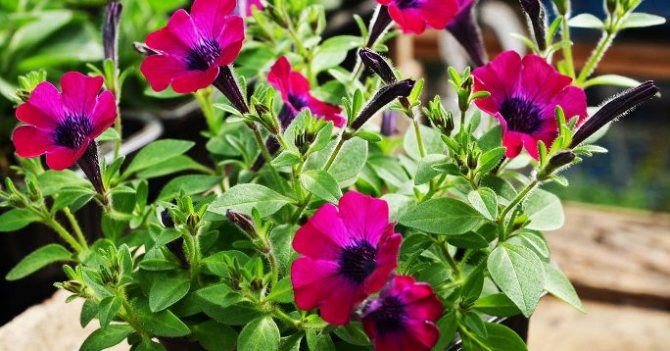

Flower lovers appreciate petunias for their abundant flowering, which lasts from the beginning of summer and ends only after the first autumn frosts. These unpretentious plants are grown in all climatic zones. They tolerate drought well, love light and can grow in poor soils.
Data on the number of petunia species existing in nature are not unambiguous, according to some sources there are about 15, according to others - up to 40. The first cultivated plants from the genus of petunias appeared in the 18th century. The main characteristics of these plants:
- stem erect or creeping with shoots of 2.3 orders;
- pubescence is present on the shoots;
- the color of the shoots is green, the shape is round;
- leaves have different sizes and shapes, alternate, have pubescence;
- flowers have a double perianth, which consists of a corolla and a calyx;
- flowers of two types are double and simple;
- the fruit has the shape of a bivalve box, which splits open when the seeds ripen;
- seed size is small.
Planting petunias in an open space
The soil is required nutritious, as the beauty is very "gluttonous". After each "dinner" the plant responds with a lush fragrance of flowers. The richer the soil, the longer the flowering will last.
The land must be fertilized and loosened before planting the plants; if necessary, humus or lime should be added if the soil is too acidic. Wood ash is what you need to supplement, it will provide soil deoxidation and scare away pests, enriching the soil with microelements.
The schematic nature of the planting is determined by the varieties of flowers, in any case, the plants should not be crowded, normally the space between the seedlings is the key to plant health. If the flower stalks of the petunia are quite large, a distance between the flowers of at least 25 cm is required, but in the case of small flowers, the distance can be reduced to 15 cm.
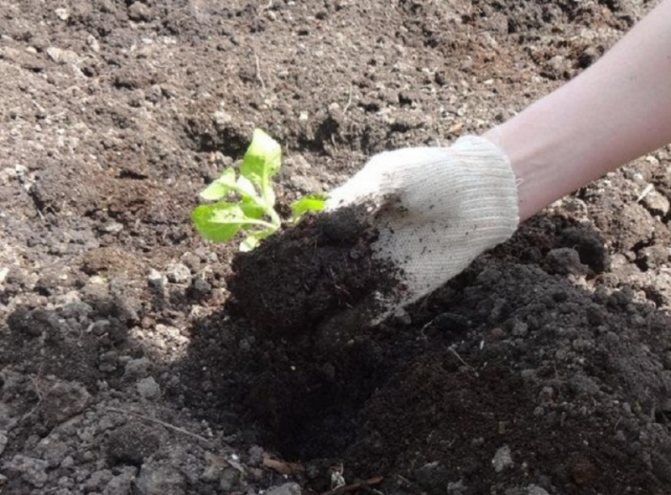

The planting process requires compliance with the rules:
- Holes can be made using a thick peg, and a cord or rope will allow you to make the correct markings on a flower bed or curb.
- Planting containers with seedlings must be moistened and overturned, carefully removing the plant. So the roots will be less injured.
- The seedlings are placed in the hole and carefully sprinkled with earth, slightly pressed into the depth of the hole.
- After that, you need to water the seedlings.
- Planting is best done in the evening or when it is cloudy outside so that the seedlings do not get sunburn.
The same manipulations are done when planting flower seedlings in pots or balcony boxes.
Throughout the season, petunia is provided with moisture, nutrition and, if required, stimulated with drugs for growth.
Transplanting petunias to a permanent place
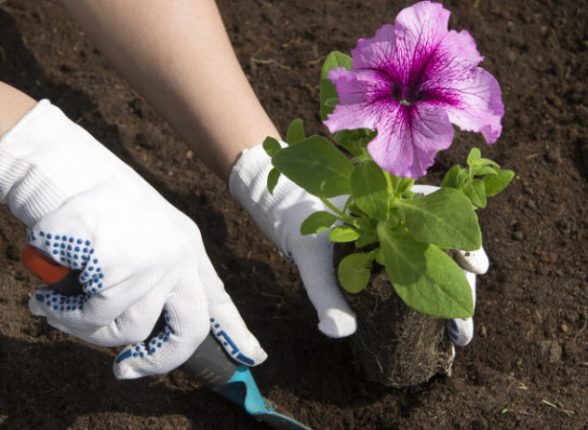

Transplanting petunia seedlings to a permanent place is not difficult. The soil must be prepared and treated with a fungicide in advance, preferably in the fall. A good time for transplanting will be a cloudy day or not a hot evening.
Transferring plants must be carried out carefully, without damaging the root system. Straighten the roots, avoiding bends. It is good to water the earth after transplantation. Water should not get on the leaves. To maintain constant soil moisture, use mulch:
When to plant petunia seedlings in open ground
Many people prefer to relax at their summer cottage, if there is one. In addition to growing vegetables and fruits in the country, many are engaged in landscape design and decoration of the territory. The most popular flower for decorating a garden bed is petunia.
The time of planting petunias in open ground
For experienced gardeners, this is a very gambling activity that brings not only pleasure, but also a fair amount of full-fledged and healthy seedlings of various colors and varieties.
The usual time for planting petunias is limited to the period from late February to early March. Under favorable conditions, you will receive ready-made seedlings in May, and you can plant on flower beds in the spring at the beginning of May. Sometimes seedlings are already planted with buds or flowers, but mass flowering should be expected by mid-June until the end of September.
You can calculate the conditional dates for planting a petunia taking into account the following positions:
- Seed sowing time;
- Germination period;
- Plant growth and development;
- The readiness of flower seedlings for transplanting into open soil.
Having come to the store for seeds, you should not buy everything that you liked. Look around and read the annotation for each variety, as a rule, there is useful information on each package. Petunia is different not only in color or shape of flowers, but in the nature and shape of the stem. There are erect varieties, and there are creeping or cascading. The selection should be carried out taking into account all the requirements and parameters.
When calculating the sowing time, you should think about other points:
- Select seeds of the desired varieties;
- Prepare soil, containers;
- Spray gun and other tools.
Most importantly, be patient and optimistic, as well as the confidence that everything will work out.
Agrotechnics
The agricultural technique for planting petunias in the ground is quite simple. The first step is to fertilize the site or flower bed. The soil must be fertile and saturated with all the necessary elements for growth.
The earth needs to be dug up, peat and humus added. Thus, you will provide petunia with organic matter for the entire growing period. Petunia likes soil with neutral acidity. Therefore, if your soil is acidic, lime must be added to it. When choosing a site, priority should be given to sandy or loamy soils.
The planting scheme for petunias depends on its variety. If the variety has large flowers, then the plants are planted at a distance of at least 25 centimeters from each other. If the variety blooms with small flowers, then you can plant it at a distance of 15-20 centimeters from each other.
The transplant process itself is very simple. First, dig small holes at the desired distance, carefully remove the plant from the cup, place it in the hole and bury it. Be very careful not to damage the roots.
Outdoor petunia care
Regular spraying
If we are talking about a sultry summer, then you need to spray twice a day. Thanks to this, the petunia will bloom profusely and magnificently.
Proper watering
It should be moderate and frequent at the same time. You can not pour water on the plant itself, it is watered strictly at the root. In rainy weather, it is better to cover the petunias, or if it is a pot planting, then bring it into the house.
Top dressing
The soil is fertilized once a week, but at the same time root and foliar feeding should alternate. Petunia is very fond of potash fertilizers and organic matter. Top dressing is carried out throughout the flowering period.
Treatment with special preparations
For example, growth stimulants or flowering agents. So, we have fully considered the seedling method of growing petunias, but the most experienced gardeners achieve excellent flowering by the seed method, that is, they immediately sow seeds in open ground.
This is done in the last days of May. The soil must first be loosened and fed. The seeds do not go deep into the soil, but are only slightly covered with earth. It is strictly forbidden to ram or crush. Such a plant will bloom later than the one that was planted by seedlings, for two weeks. But on the twentieth of June, the garden bed acquired new colors.
Many gardeners notice that new plants sprout on their own in the flower beds where petunia was planted last year. This may well happen in a flower bed that has been poorly dug up. But this once again suggests that petunia can be easily grown from seeds and without even planting seedlings. Even the most inexperienced gardener can handle plant care. Moreover, petunia will reward him with abundant, colorful and unusual flowering, which will decorate any suburban area or garden flower bed.

